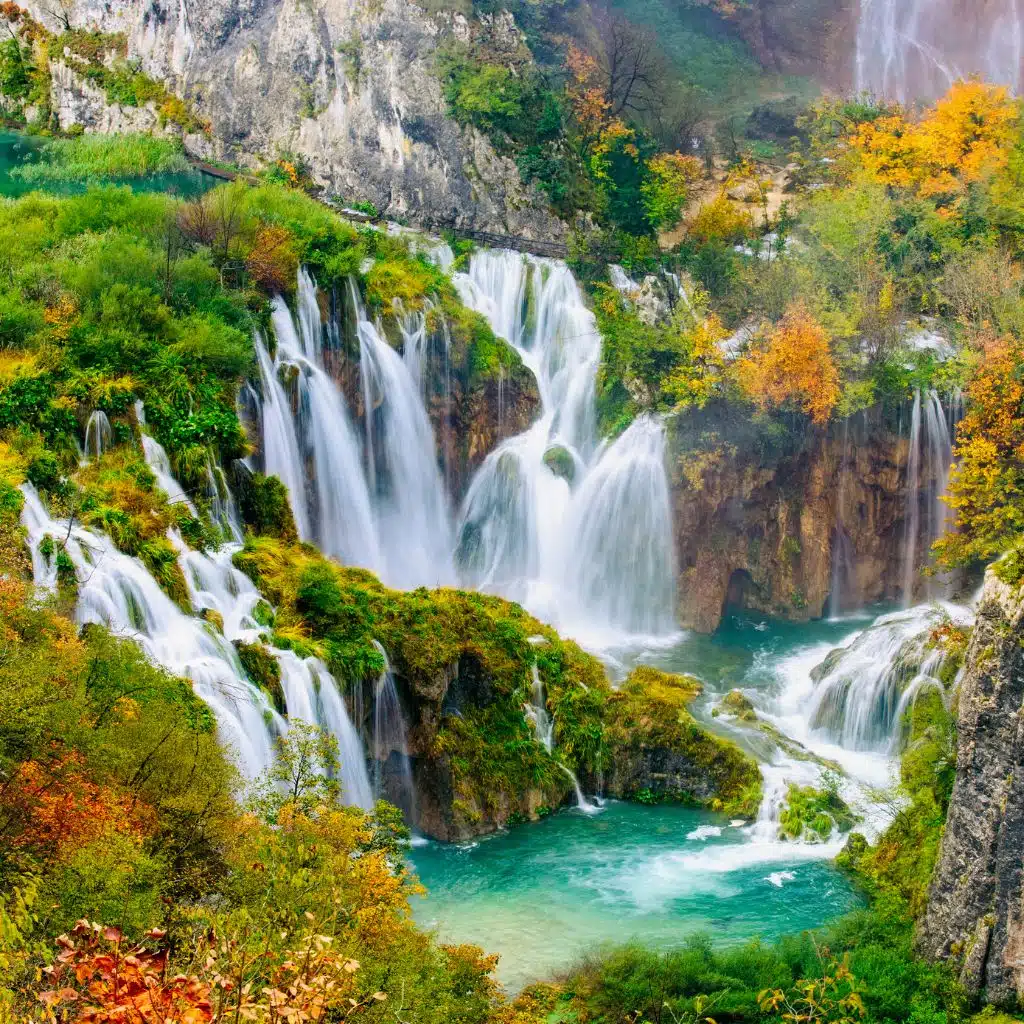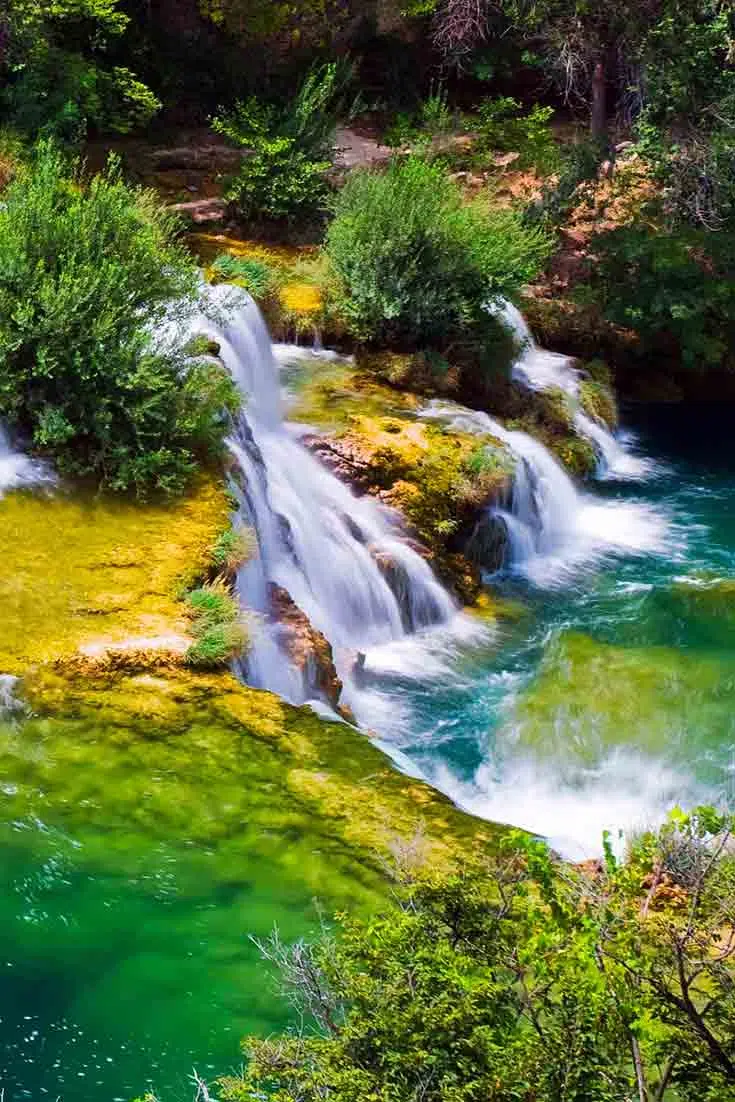Croatia boasts some of the most beautiful and awe-inspiring waterfalls ever created—from single high drops to multitiered cascades. In an epic landscape unlike any other, the falls stand in lush river canyons framed by karst mountains and Mediterranean forests.
Falls are always exciting to hike to, whether you're a first-time visitor as a tourist or have lived in Croatia for years.
Visit Plitvice NP to see one of the most popular waterfalls in Europe, the Great Waterfall. Croatia's national parks are also home to several other very attractive waterfalls.
Like, Roški waterfall within the National park Krka, some waterfalls are easily accessed by vehicle. Others, like the Gubavica waterfall in the Cetina canyon, require more of a hike to access.
Here is a map of Croatia's waterfalls to help you get a better orientation of where they are located and if you can squeeze in an excursion to the closest ones.
Always check local conditions before starting your trip. Especially in the summer, when a lot of the waterfalls are dry. If you're considering a vacation there, you might want to add some of the following 25 waterfalls to your Croatia A-list.
Great Waterfall (Veliki Slap)
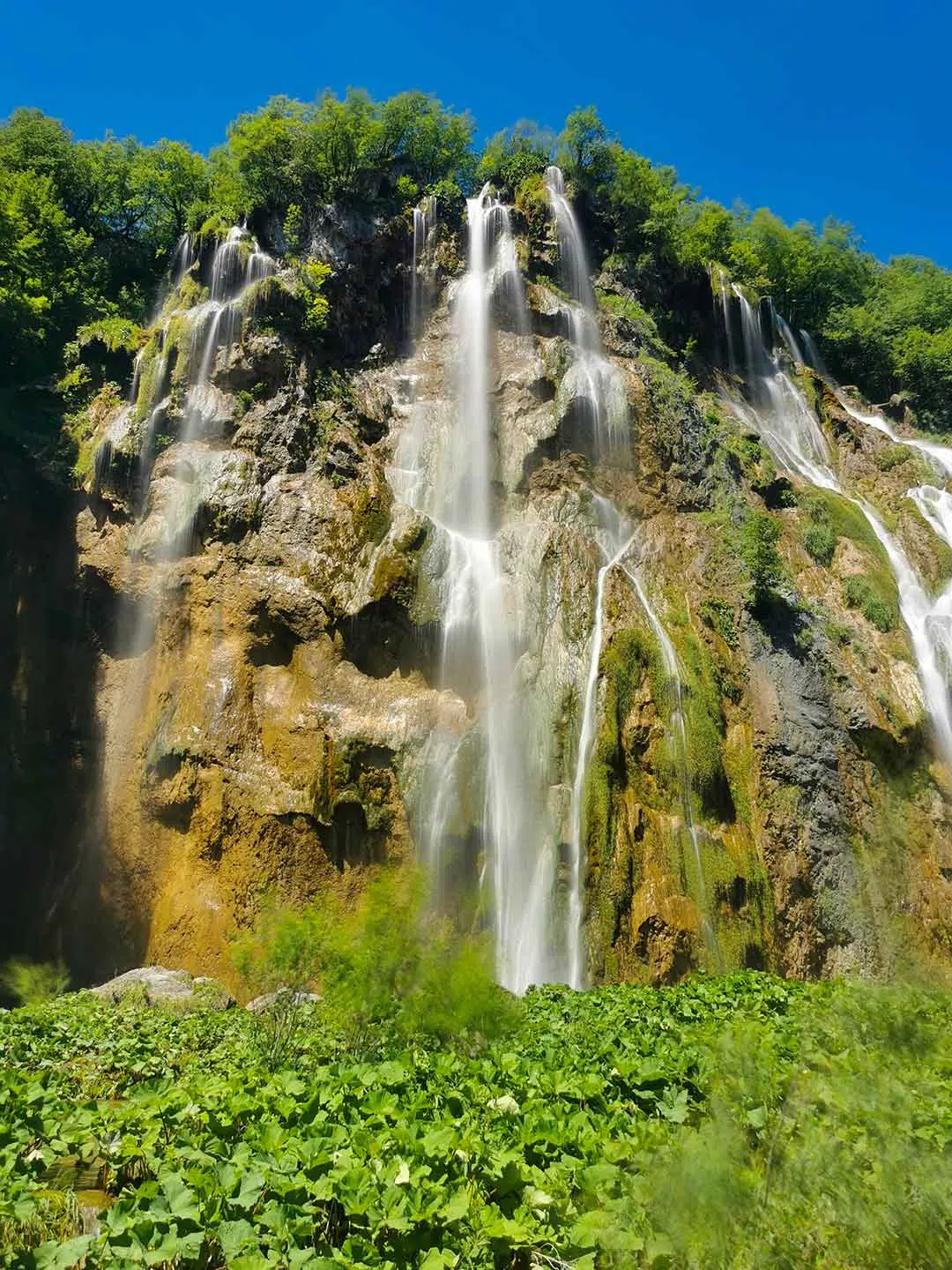
The Great Waterfall is the highest in Croatia. It is located in the Plitvice Lakes National Park, a UNESCO World Heritage Site, an essential place to visit on your voyage across Croatia. The National Park has 16 lakes that cover approximately 8 km2.
The Great Waterfall forms when the Plitvice stream falls with a thunder of water over a cliff of 78 meters. Together with the water from the Lower lakes, it creates the Sastavci Falls, which after 150 meters, falls down the travertine barrier and forms the river Korana.
Tip: The waterfall is the standout feature of the park. If you enter from entrance 1, it will take your eye straight away. Many people walk directly from Entrance 1 to the Veliki Slap, often in large groups that come from bus tours. I advise visiting early to avoid queues.
Great Waterfall (Veliki slap in the Croatian language) is considered the most beautiful of all Plitvice waterfalls. Its changing colors astonish visitors. Minerals in the water and the amount of sunlight affect its color. During the day, the water will appear green, gray, and blue.
While other Plitvice waterfalls were formed by the overflow of water between lakes over travertine barriers, The Great Waterfall was created by the Plitvice stream, which springs 3 km west at the foot of the mountain Preke Kosa.
Plitvice Lakes are the richest in water in spring and autumn. After a few days of rainfall, the underground wave blows out the water. As a result, the stream flows down the waterfalls more vigorously.
Interesting: It is forbidden to walk under the waterfall and outside the marked paths to protect tufa limestone at the foot of the Great Waterfall. But the walking trails get close to it and well sign posted and the routes are well set up.
If you are visiting in the winter, you might find the waterfall is almost completely frozen, making a beautiful ice sculpture of enormous proportions.
Roški Slap Waterfall
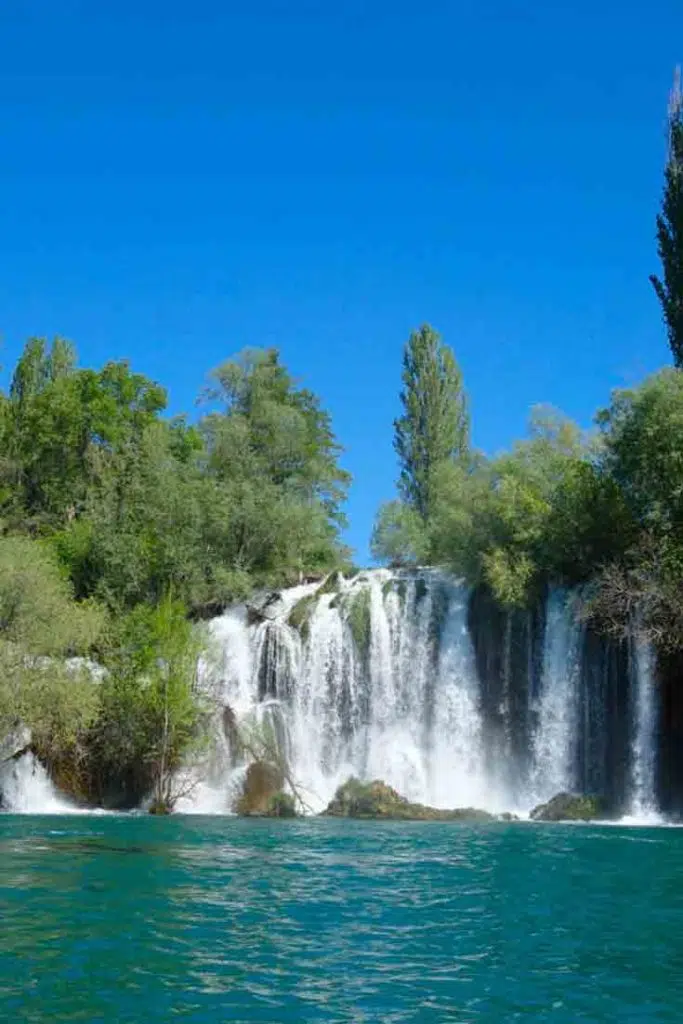
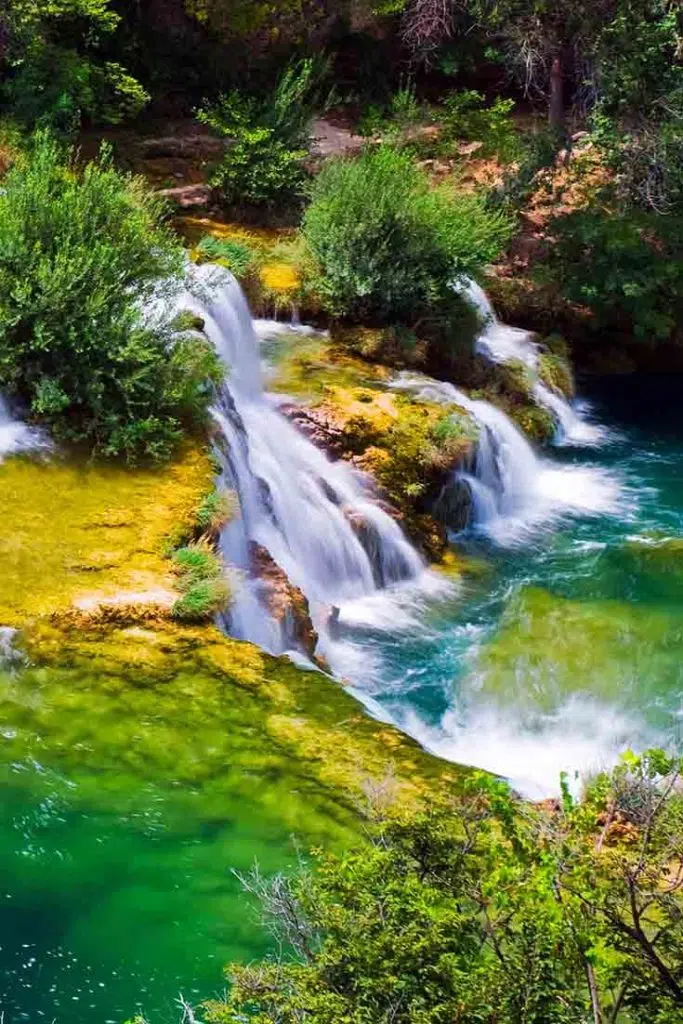
Roški waterfall is a waterfall consisting of 22.5 meters high main waterfalls and countless backwaters, cascades, and travertine islands. Roški waterfall is located about 36 km downstream from the source of the river Krka in the NP Krka. This waterfall is at the end of the barrier where the Krka River empties into Visovac Lake 15 meters below.
The Krka NP ticket is valid for entrance at Roški slap. There is a beautiful lake where you can swim. It is about a 5 mins walk from the car park. You can reach the waterfall by boat or car (a 30-minute drive from main entrance).
The waterfall's travertine formations are tufts, thresholds, caves, small barriers, and tapers. The tapers appear at the main waterfall's base and signify the Roški waterfall's uniqueness.
The beginning of the barrier is a series of small cascades (popularly dubbed Necklace) followed by numerous backwaters and islets. The length of the barrier is nearly 650 meters, at its widest is approximately 450 meters wide. From Necklace, more than 500 wooden steps lead to the Oziđana cave.
Interesting: 5000-year-old bones were found in the Oziđana cave that dates back to early inhabitants. The cave is small, but there is a boardwalk through it. Visiting the cave and reading all the signs posted will not take more than 30 minutes.
Roški waterfall was named after the hill fort Rog (Rog means horn in Croatian), whose ruins are almost completely gone today. The road that connected the riverbanks in Roman times goes across the travertine waterfalls.
On both riverbanks of Roški Slap are numerous watermills, which these days are gift shops and ethnographic monuments. Roški Slap is less crowded than the rest of NP Krka. Family-friendly attractions include a swimming area in the lake right next to the restaurant Kristijan and a large shaded area with streams.
Skradinski Buk Waterfall
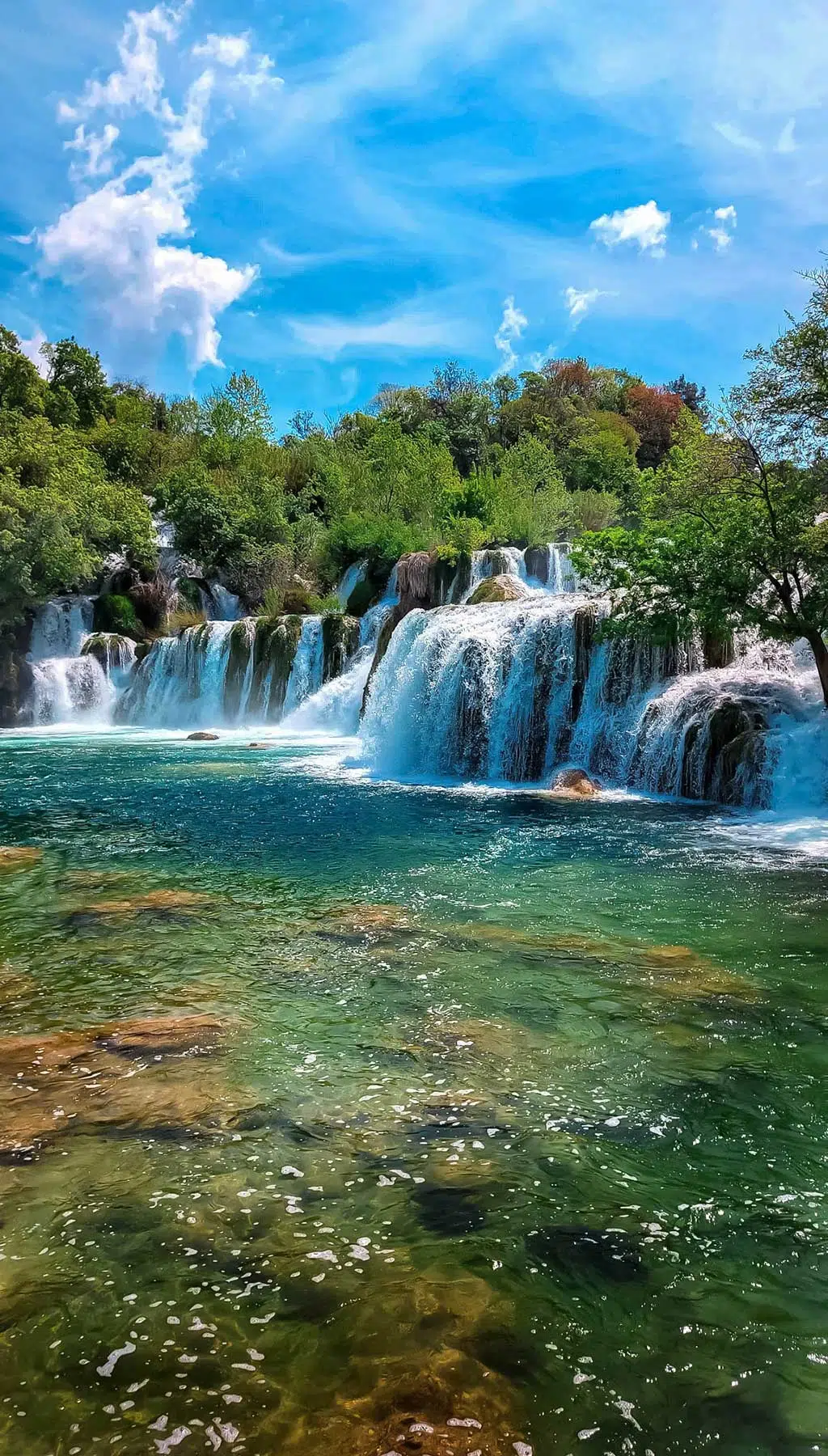
Skradinski Buk is the longest waterfall on the river Krka in National Park Krka. It is located at the very end of the Krka River, near the city of Skradin. It is made up of beautiful travertine barriers, islands, and lakes, and many tourists journey year-round to see this quite stunning waterfall.
Buk in Croatian means noise produced by strong water movement. Skardinski Buk consists of 17 steps totaling 800 meters in length. The height difference is 45 meters.
A lake lies at the bottom of the waterfall. Swimming in the lake of Skradinski Buk is not allowed anymore. On both sides of the waterfall are landscaped and improvised lookouts which offer great views of the beautiful surrounding nature.
Most of the travertine of Skradinski Buk is less than 10 thousand years old. The river's former watercourse has 125 thousand years old "dead tufa."
The growth of the travertine barrier on Skradinski Buk caused the upstream lake watering of the Krka River to Roški slap, thus creating one of the most unique and beautiful landscape images of the National Park. The mouth of the river Krka (estuary) begins below Skradinski Buk.
Skradinski Buk is generally the most vibrant part of the Krka National Park, where you can find many souvenir shops and restaurants. A network of trails and bridges allows visitors to walk safely and enjoy the view year-round. Skradinski Buk, like other places in the park, has restored watermills, which have been using water flow power for centuries.
Mills have been used as souvenir shops or spaces for showcasing local ethnographic collections.
Tip: The Skradinski Buk locality is reachable through the Lozovac entrance. Free parking spaces for visitors. Free bus transport from the admission to the waterfall is provided from April to November.
There is a second entrance in Skradin, and tourists are taken to the waterfall by boat organized by the National Park "Krka." Nature lovers can enjoy walking the 875 m long path from Lozovac to Skradinski Buk or the 4 km long course from Skradin. Additionally, boat trips to Visovac and Roški slap are available from Skradinski Buk.
Zrmanja Waterfalls
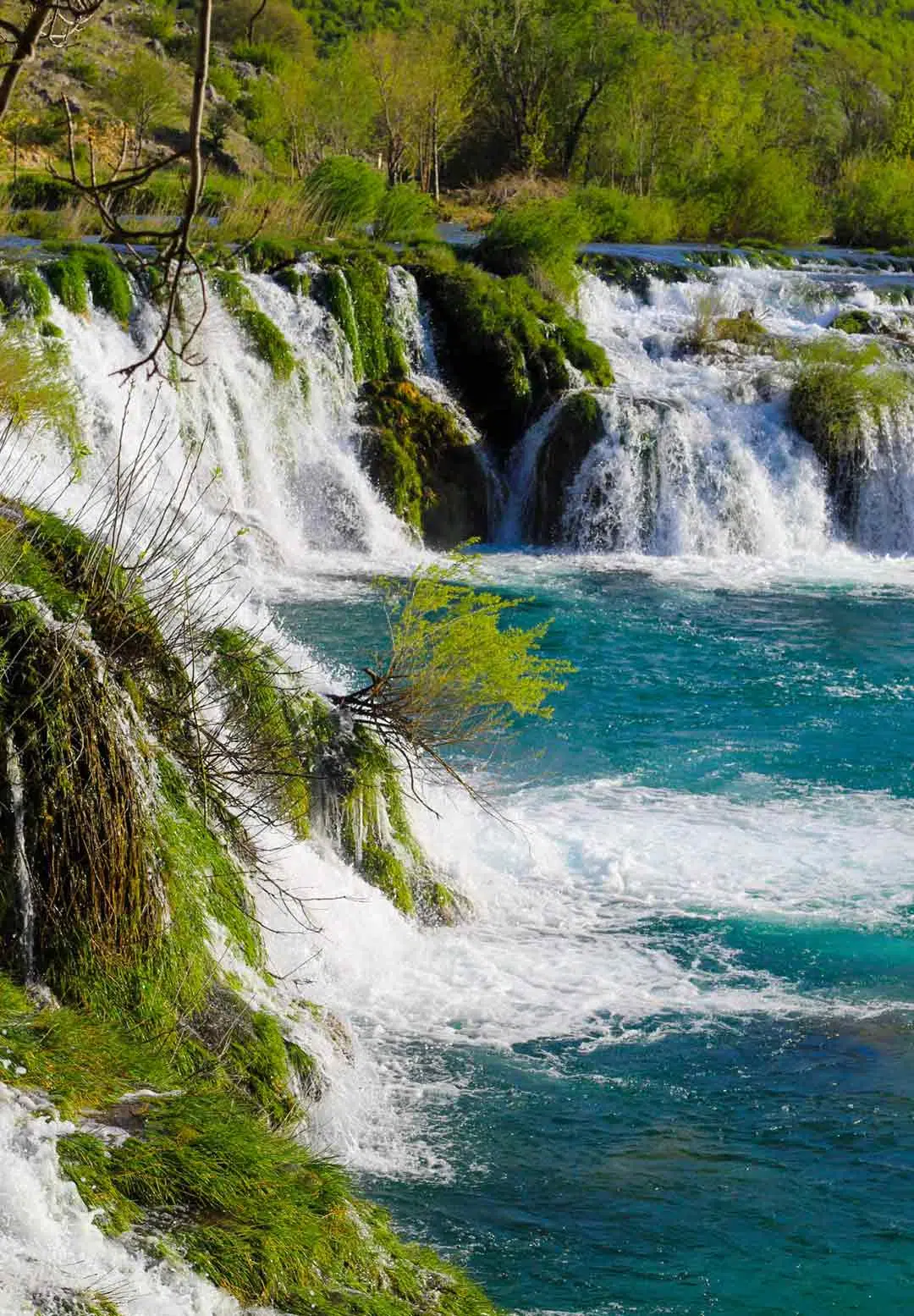
Zrmanja is one of the wildest rivers in Croatia. It is 69 kilometers long and originates in the mountains of Plješevica. It flows in rugged karst, through several canyons and karst fields, and into the sea. Tufa and waterfalls along the river make an ideal setting for adrenaline-fueled rafting and canoeing.
One of the most beautiful waterfalls is the hard-to-reach 11 meters high Visoki Buk near Bilišane (15 kilometers east of Obrovac).
Interesting tufa rocks, fast rapids and waterfalls along the river make an popular destionation for adrenaline seeking visitors wanting to experience rafting or canoeing watersports.
Visoki Buk is found in a canyon that begins at the river's exit from the Žegar field. Then, the river recedes into the high cliffs, culminating downstream after the mouth of the Krupa river, Zrmanja's strongest tributary. Empowered by the extremely travertine waters of the Krupa River, it forms the Visoki Buk together.
When looking at Visoki Buk, millions of tiny drops burst in white jets down the eleven-meter-high barrier, completely overgrown with grass. Below Visoki Buk, the canyon sides rise to three hundred meters high. A rock called Obli Kuk protrudes from the Zrmanja riverbed like an obelisk.
Zrmanja river creates several waterfalls: Visoki buk, Berberov buk, Devića buk, Šupkov buk, Jankovića buk, Ogaro or Ogariv buk and Muškovci.
Zarečki Krov Waterfall
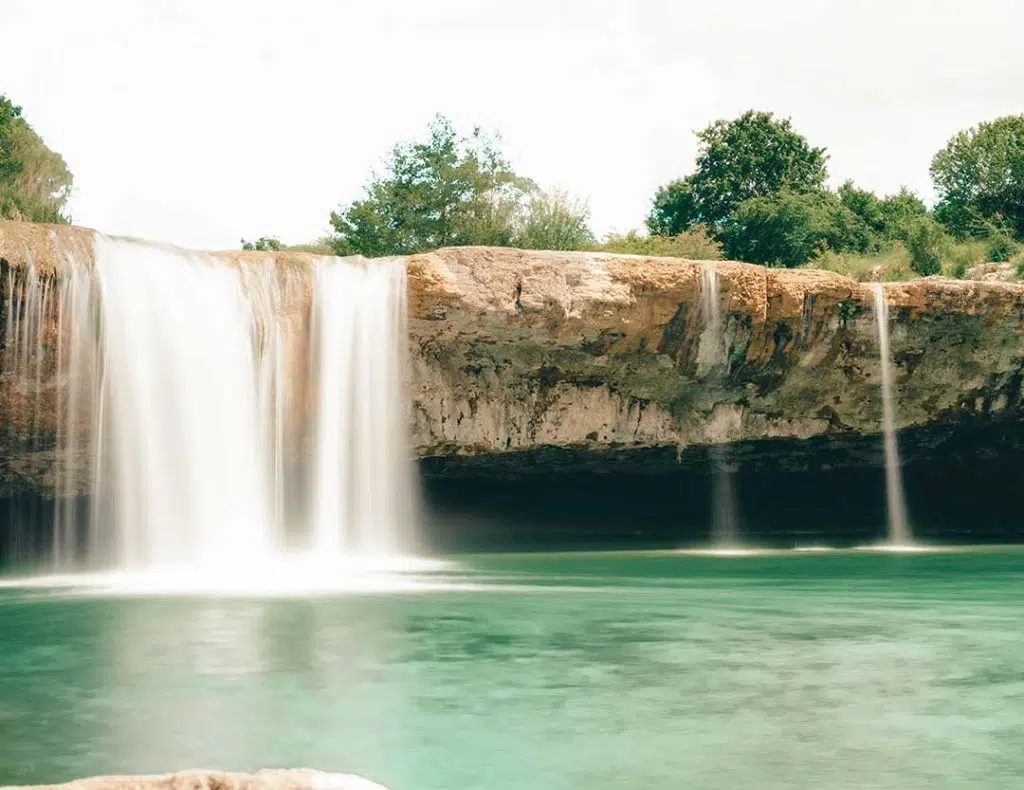
One of the tallest waterfalls in the Istria region is Zarečki Krov, a waterfall on the Pazinčica stream. Zarecki Roof, as the name suggests, is a spacious cave that resembles a roof above which the river Pazinčica creates a ten-meter high waterfall and drops into a lake ten meters deep. Along with Pazin Cave, it is the most interesting natural attraction of the Pazinčica watercourse. It is located 3 km from Pazin towards Cerovlje.
There is a cave under every waterfall on the Pazinžica river. For example, downstream from the Zarečki Krov, there is a cave and the Pazinski Krov waterfall.
Tip: Unlike most attractions in Croatia, access to the Zarečki Krov waterfall is free. Therefore, Zarečki Krov is a popular place for swimming, diving, walking, fishing, water polo, and picnics.
In addition, there are numerous routes for sports climbing of various difficulties. One is the Snake climbing route, which includes climbing the cave ceiling and is the most difficult in Croatia.
This waterfall offers the perfect spot for cliff jumping. The drop is around 10 meters, and the water below is deep enough to jump safely.
Mrežnica Waterfalls
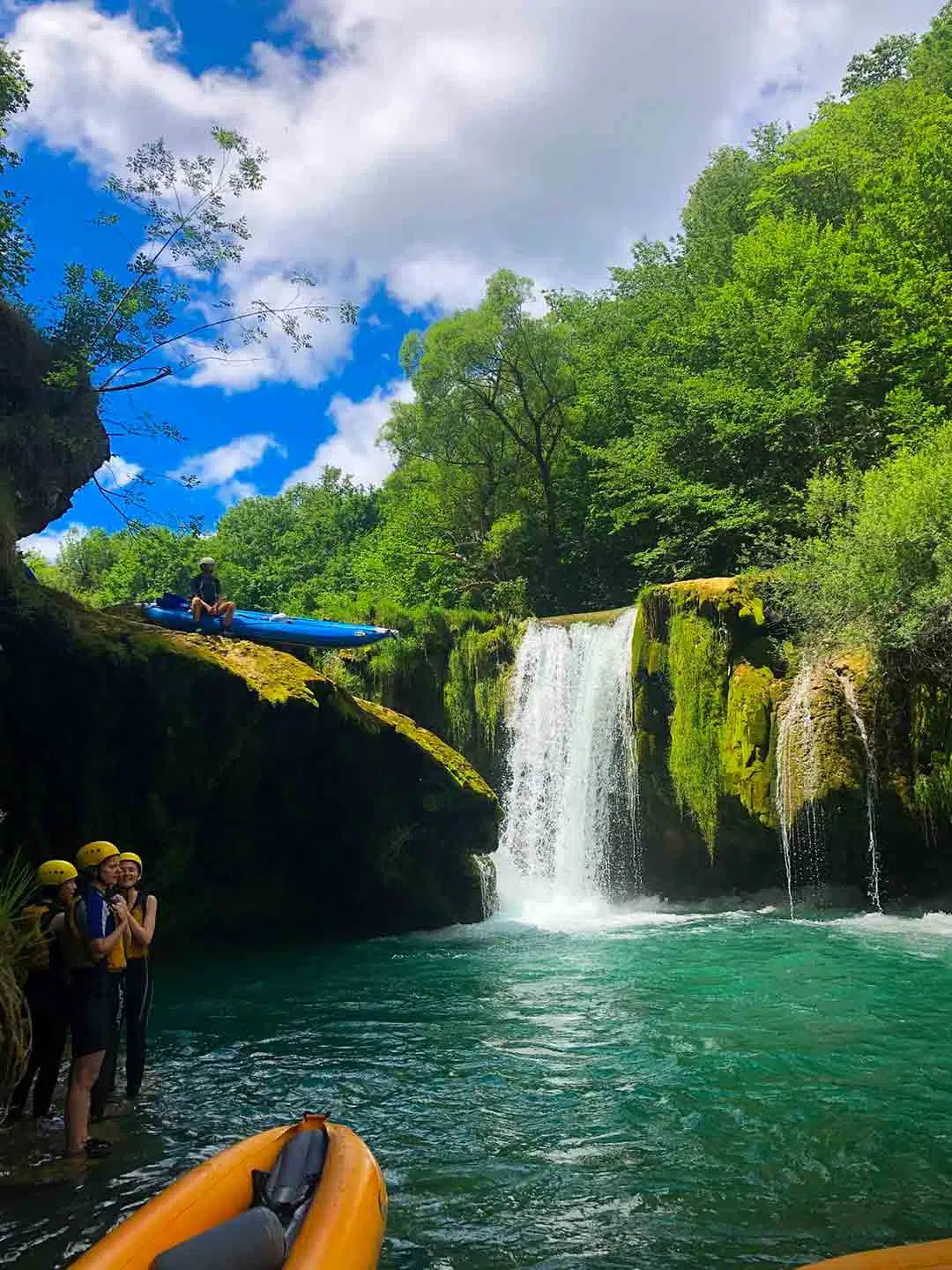
Mrežnica is a river of canyons, travertine barriers, and lakes. Springing near the town of Slunj, it flows into the Korana River at Karlovac. The river is 64 kilometers long and features 93 travertine barrier waterfalls that intertwine along its entire route, creating a series of interconnected lakes.
More important than the number of waterfalls on Mrežnica is their diversity. Each more beautiful and entirely different than the next, the waterfalls line up its entire length. While most are not particularly high, six of them are taller than six meters.
Interesting: There is a belief that the series of lakes resembles the eye of the network, which is why it was named Mrežnica which means retina in English.
A landscape full of changing waterfalls and elongated lakes with an ambiance of shallow karst and lush greenery creates an extremely popular and dynamic destination.
Many ancient Roman, Illyrian, and early Croats left archaeological remains on its shores for thousands of years. Over the centuries, the population has harnessed the water power of Mrežnica and built numerous mills (mills) around it, many of which are still in use today.
Mrežnica river falls are a particularly popular destination for rafting, canoeing, and kayaking. Add it as a stop on your journey if you want to find plenty of unique places to enjoy swimming and sunbathing.
Sastavci Waterfall
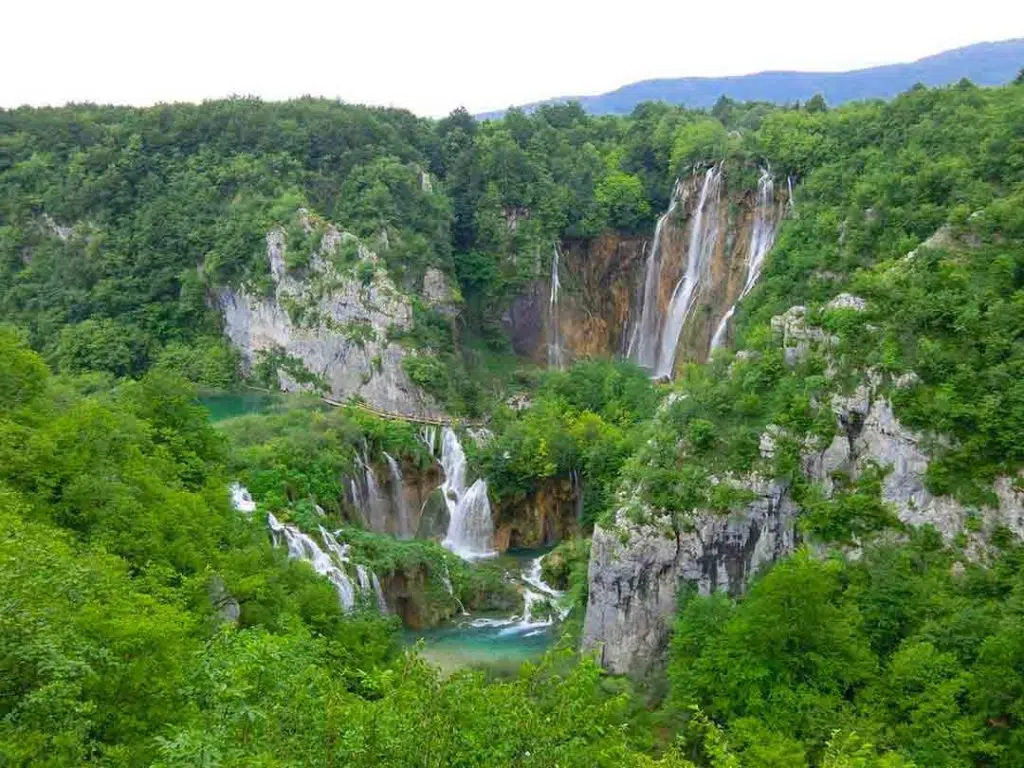
On the edge of the Novakovića Brod lake is the stunning Sastavci waterfall, one of the most picturesque waterfalls in the Lower Lakes area of the Plitvice Lakes National Park. This waterfall is where the water of Plitvice Lakes and the river Plitvice drops from about 26 meters (80 feet) into the Korana river.
It is so beautiful that those who have visited this waterfall claim they can never get tired of looking at it. The Sastavci waterfall comprises numerous cascades where water flows down over outcrops of dark brown rocks before landing in the clear pool below. A clear view of other falls of Plitvice, such as Veliki Slap, gives the impression that the landscape consists of nothing but waterfalls.
Wander around various trails that provide access to numerous viewing areas near the Sastavci falls. You'll probably never tire of the new and unique waterfalls that seem to be lurking around each corner, just waiting to be discovered.
Krčić Waterfall
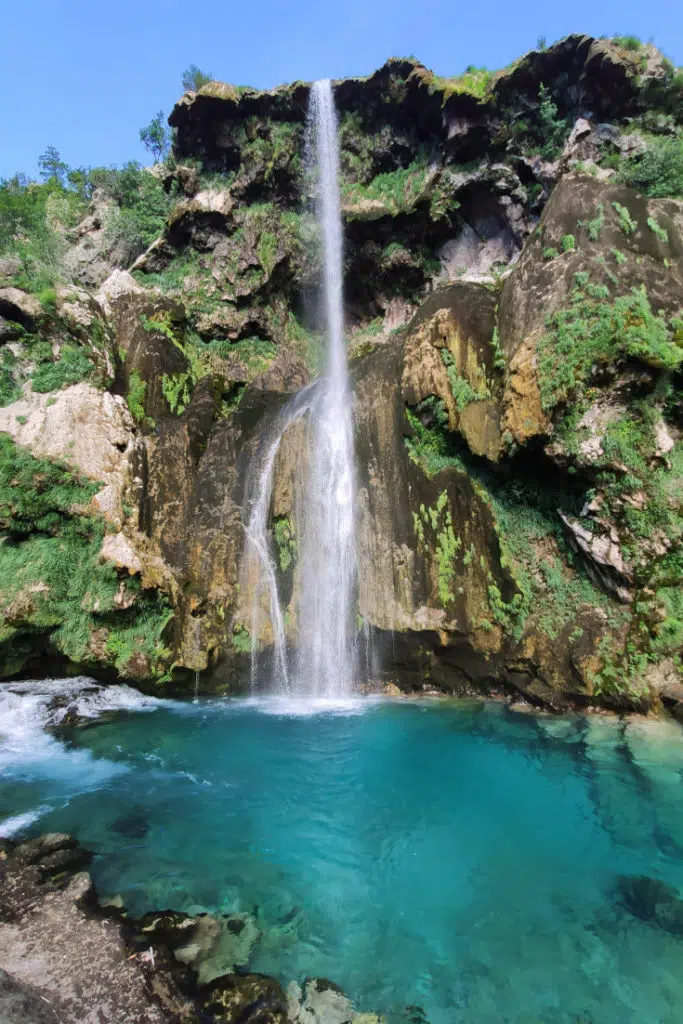
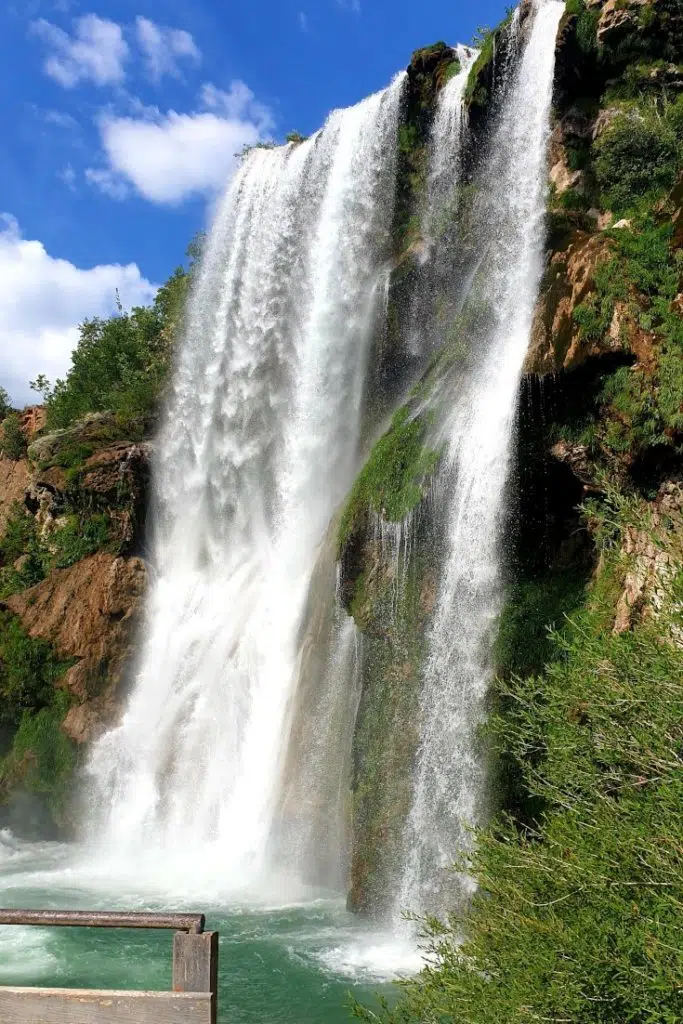
Along the bed of the Krčić river, there are several travertine waterfalls, of which the largest and most beautiful is the waterfall Krčić. Krka river springs underneath it.
The waterfall is 22 meters high, and when it's the rainy season, it gets to 30 meters in width. It is also known as Veliki Buk and Turopoljski Buk. It is located next to the town of Knin and is fed by water from the Dinara mountain.
Interesting: Krčić waterfall was reduced to a seasonal waterfall with explosive demolition and chambering of the Krčić river travertine dam in efforts to build a hydroelectric power plant.
As autumn turns into spring, Krčić slams into Krka with all of its might, and as winter settles in, it welcomes visitors with snow and ice crystals. However, during the summer, when the weather is hot and dry, the waterfall dries up, leaving behind green and white rocks that look like they have melted. During the summer, the waterfall disappears, and the cave entrance emerges from which the Krka flows.
Krčić waterfall has its legend. There used to be a fort on the hill to the left of the waterfall that served to defend the bridge. Legend has it the bridge will be rebuilt when people stop fighting each other. Then the waterfall will stop drying up, and the water will flow non-stop.
A 15 km long macadam road along the Krčić River constructed by order of emperor Napoleon 200 years ago connects Knin and Kijevo village. This old road takes you further down Krčić canyon to the source of the Cetina river.
Manojlovac Waterfall
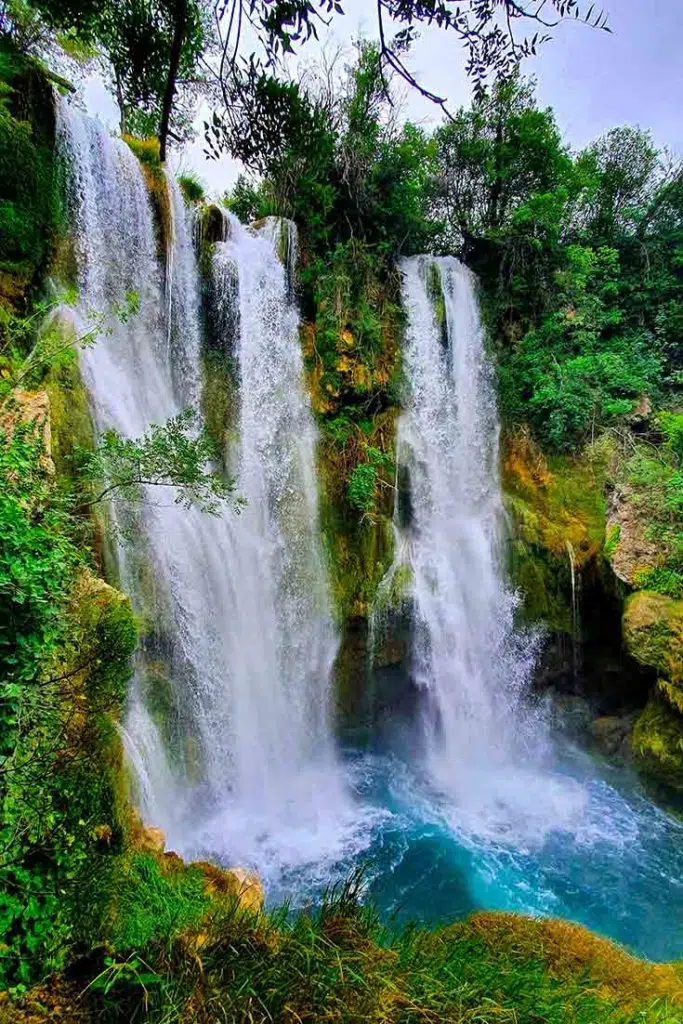
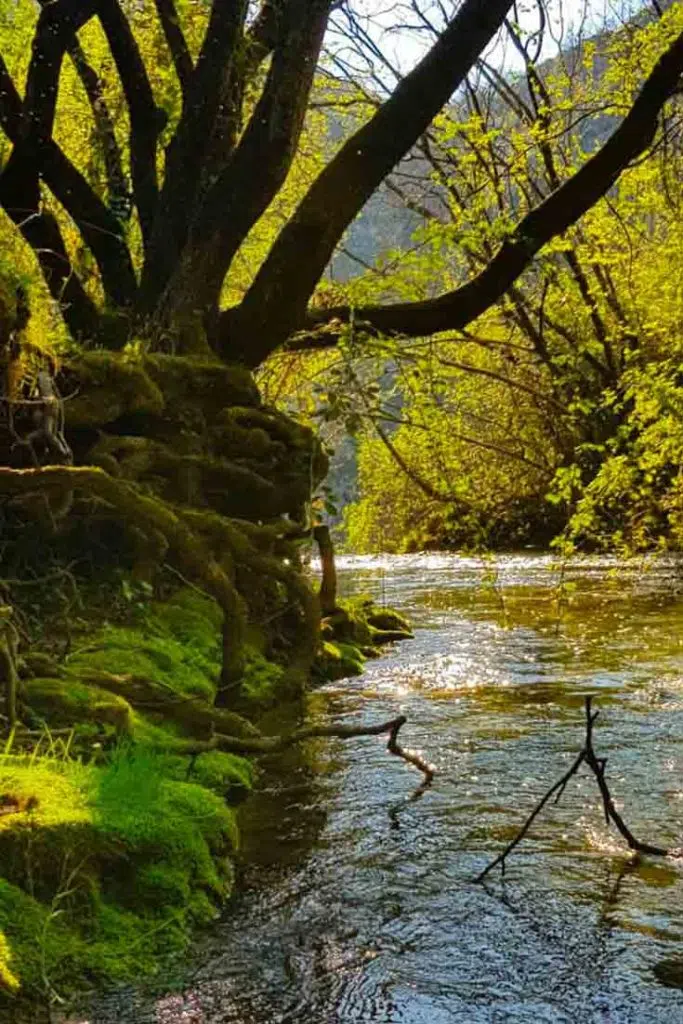
Manojlovac waterfall (or waterfalls since there are smaller waterfalls around the big one) can be found at Kistanje on the way to Knin, near the archeological site of Burnum. Manojlovac is the largest waterfall on the river Krka, on the border of the municipality of Promina and Ervenik.
Photo Tip: The best time to choose to visit and to experience the full beauty of this waterfall is in the spring when the snow on the Dinara and the surrounding mountains melts, and the Krka river flows at the speed of up to 250m3 / s.
The Manojlovac waterfall is tumbling down the cliff at the spot where Krka is making a 180-degree turn, making the view of the falls even more impressive.
Five waterfalls, a lake, and rapids are located within four kilometers of NP Krka surrounding Manojlovac. Manojlovac consists of a series of travertine barriers with a total height of 59 meters, of which the tallest is 32 meters.
Interesting: Visitors seeking to take in the views of this beautiful waterfall can use a path leading to a lookout. A memorial plaque honors Austrian Emperor Francis Joseph I, who enjoyed the beauty of the Manojlovac waterfall with his wife Elizabeth from the lookout point.
Until the 1940s, a mill owned by the Manojlović family operated at the Manojlovac waterfall. Even today, the walls of that mill are overgrown with ivy on the spot.
The waterfall was probably named after the inhabitants who lived next to it. In his book "Journey to Dalmatia," Alberto Fortis even mentioned the Manojlovac waterfall and a small village next to it.
Pevalekovi Slapovi
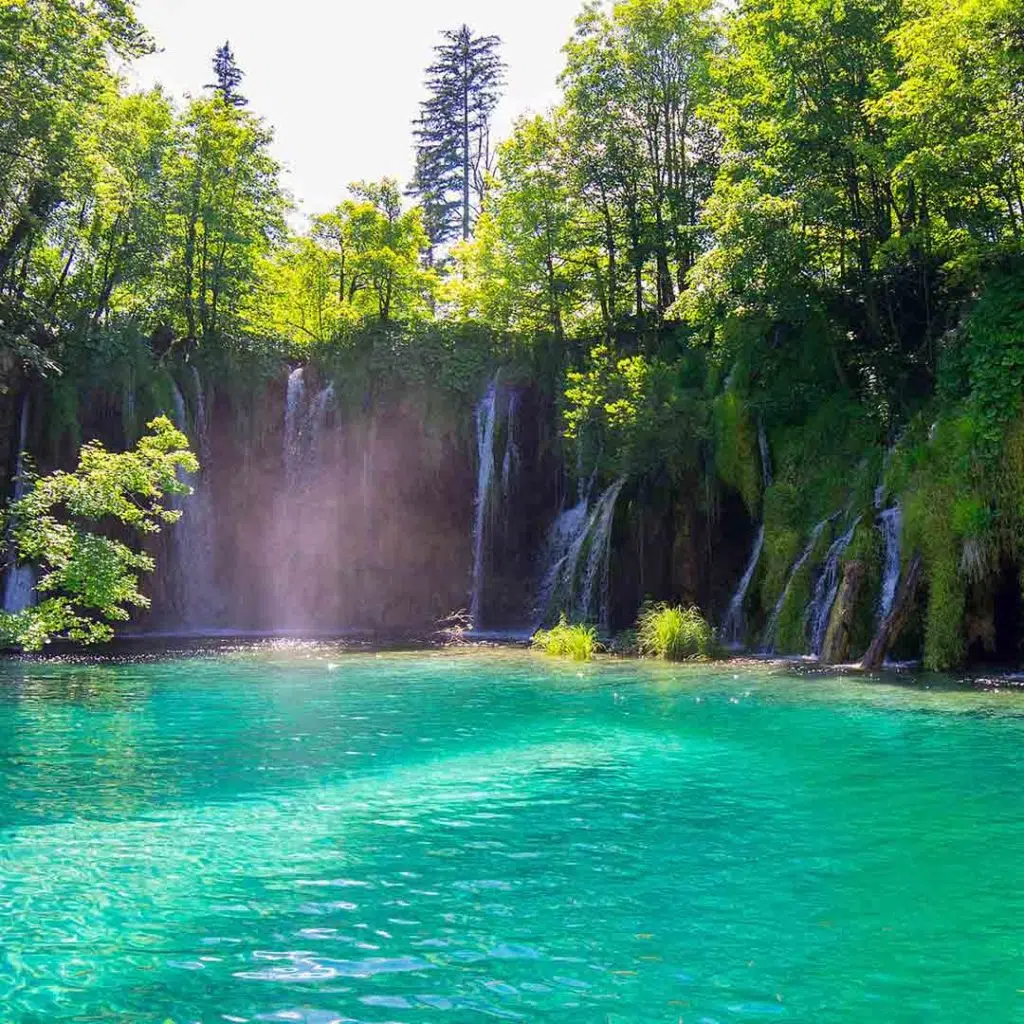
Pevalekovi Slapovi waterfall is hidden deep in the Plitvice Lakes National Park, making it less popular and difficult to find if you're cruising aimlessly around the park. But travelers who manage to find it often say it's a wonderful sight.
This pretty waterfall has a crest in the shape of a half-circle almost 50 feet high, from which water drops into a clear water pool below. Surrounding the falls are sheer rock faces dotted with trees.
Plitvice National Park isn't free, but considering the scenery, it's a bargain, and a complimentary shuttle will take you to the top lake.
Tip: Plitvice National Park isn't free, but considering the scenery, it's a bargain, and a complimentary shuttle will take you to the top lakes.
Swimming is not allowed at Pevalekovi Slapovi, just like all other waterfalls or pools in Plitvice Lakes NP.
The waterfalls got their name from dr. Ivo Pevalek, whose valuable and numerous scientific papers are research results on the karst river and lakes.
Rastoke Waterfalls
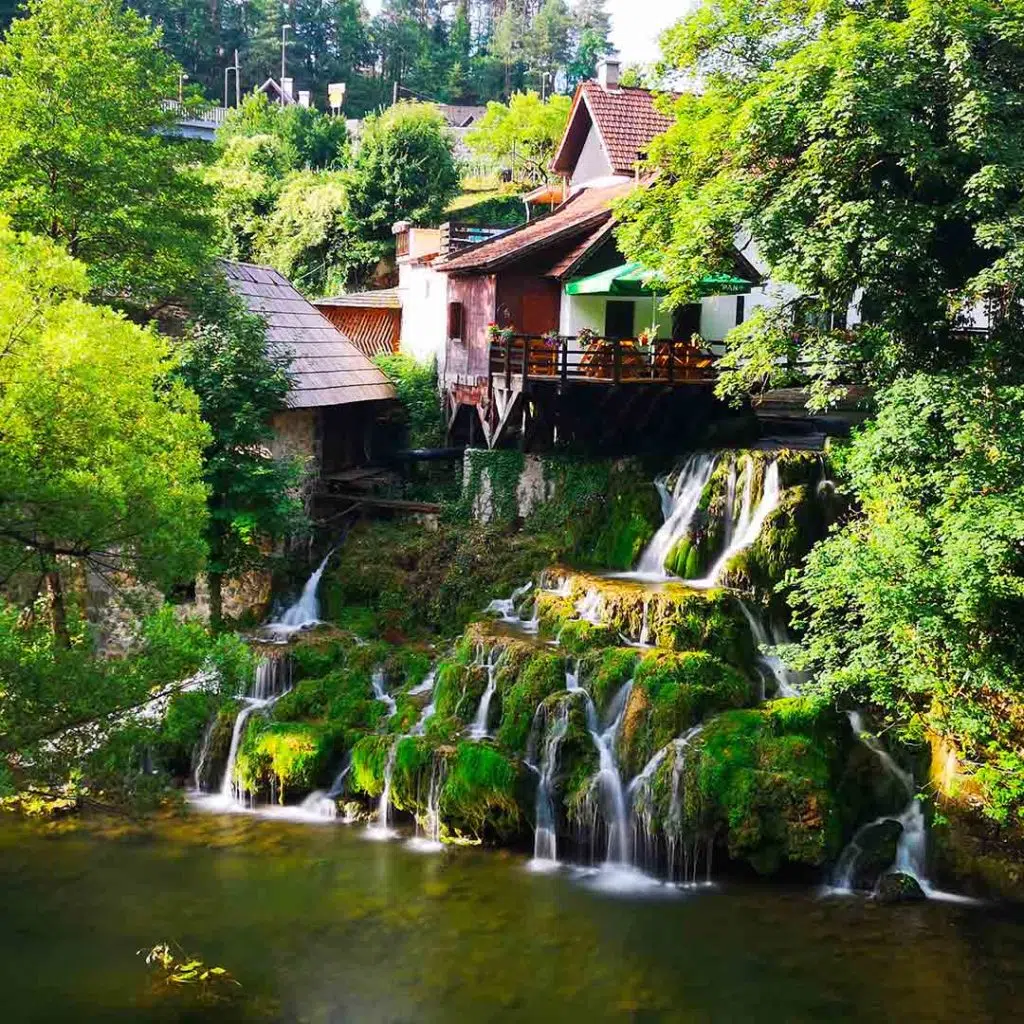
One of the most attractive tourist attractions in Croatia is the picturesque town of Rastoke. Rastoke falls are where Slunjčica or Slušnica, a short karst river and tributary of the Korana river, spread over the travertine rocks, creating 23 waterfalls.
Many call Rastoke Small Plitvice because the geological composition of the waterfalls is identical to that in the Plitvice Lakes National Park, from which Rastoke is only 30 kilometers away.
Location: The waterfall location of Rastoke is perfect for young couples with kids, unlike most others on our list. You can go canoeing and kayaking, take long walks through the forest, or swim in the river near. Everything is within walking distance.
Rastoke waterfalls have colorful names behind which interesting stories are hidden.
- Buk - The noisiest waterfall is aptly named Buk (noise in Croatian). This waterfall is the crown of a trip to Rastoke because it is the largest and richest in terms of water flow. If not for the collapse of huge travertine barriers in 1914, which elevated the flow of the Korana river, the Rastoke Buk would have been even larger and more interesting.
- Hrvoje's Waterfall got its name after a landslide broke off two huge travertine boulders from the waterfall. Symbolically, the two boulders, which are forever separated, provide a touching depiction of two people not meant to be together. The legend describes the last leap of Hrvoje, a jumper unhappily in love, into the depths of the water, similar to that of an abyss of feelings leading to desired love.
- Vilina Kosa "Fairy Hair" waterfall is reminiscent of the thick, untangled hair of mythological fairies the old Slavic people admired. Supposedly, fairies had silver hair and sang while combing their long hair by the water while seducing men with their singing.
- Prvi slap (First Waterfall) is a waterfall flowing beneath a unique travel accommodation, a former mill. A chance to test the old Rastoke saying that you sleep best beneath a waterfall and listen to the calming sound of water.
Since the town of Rastoke has been building mills for centuries, the first to be powered by water rather than people or animals, today mills are a tourist attraction and a testament to the harmony that man and nature can achieve.
Sopot Waterfall
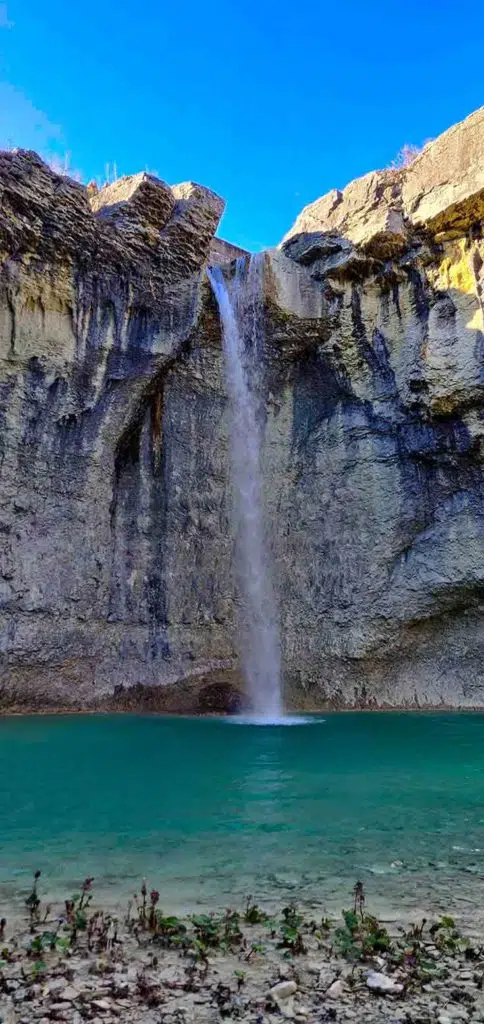
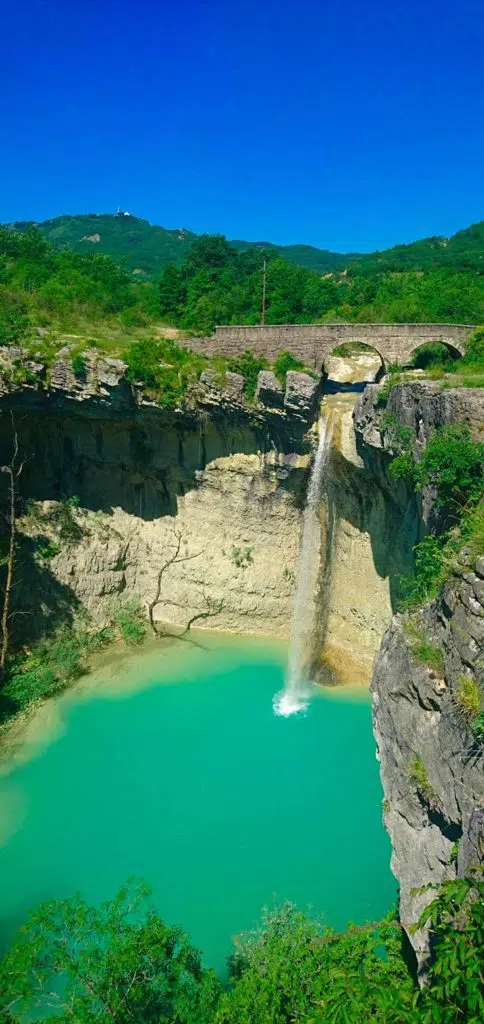
The Sopot waterfall is located on the Švićki stream deep inside the Istria region of Croatia. It's not far from Pićan, near the village Floričići, close to Pazin. The trail of St. Roko starts in Pićan and offers attractions related to interesting legends, and ends at Švićki Potok, right next to the 24.5 m high Sopot waterfall. The turquoise lake that forms beneath the Sopot waterfall is an ideal place for excursions and nature trips.
Location: The best time to visit the Sopot waterfall is in the autumn, winter, or spring, after a heavy rainfall since there is more water and it is not too hot. If the summer is dry, there will be no water, no waterfall.
Caution is needed as the crater where the waterfall lands is not fenced, posing a risk of falling.
A few meters away from the Sopot waterfall is the Višestoljetni (Centuries Old) bridge built in Napoleon's time connected Pićno with the surrounding villages. Unfortunately, the water damaged this bridge several times, but the locals always rebuilt it. The last renovation was in 1953.
Next to the waterfall is a table with benches for rest or a picnic, and you can choose whether to return to the Pićan hiking trail of Sv. Roko (Istra trails 702) or continue towards Gračišće, along the route of Sv. Simeon (Istria trails 701).
Access: Reaching Sopot waterfall by car is possible from Floričići village, which you can reach from the main road Pazin-Labin by turning at Zajci and going towards Švići.
Copot (Sopot) Fall near Buzet
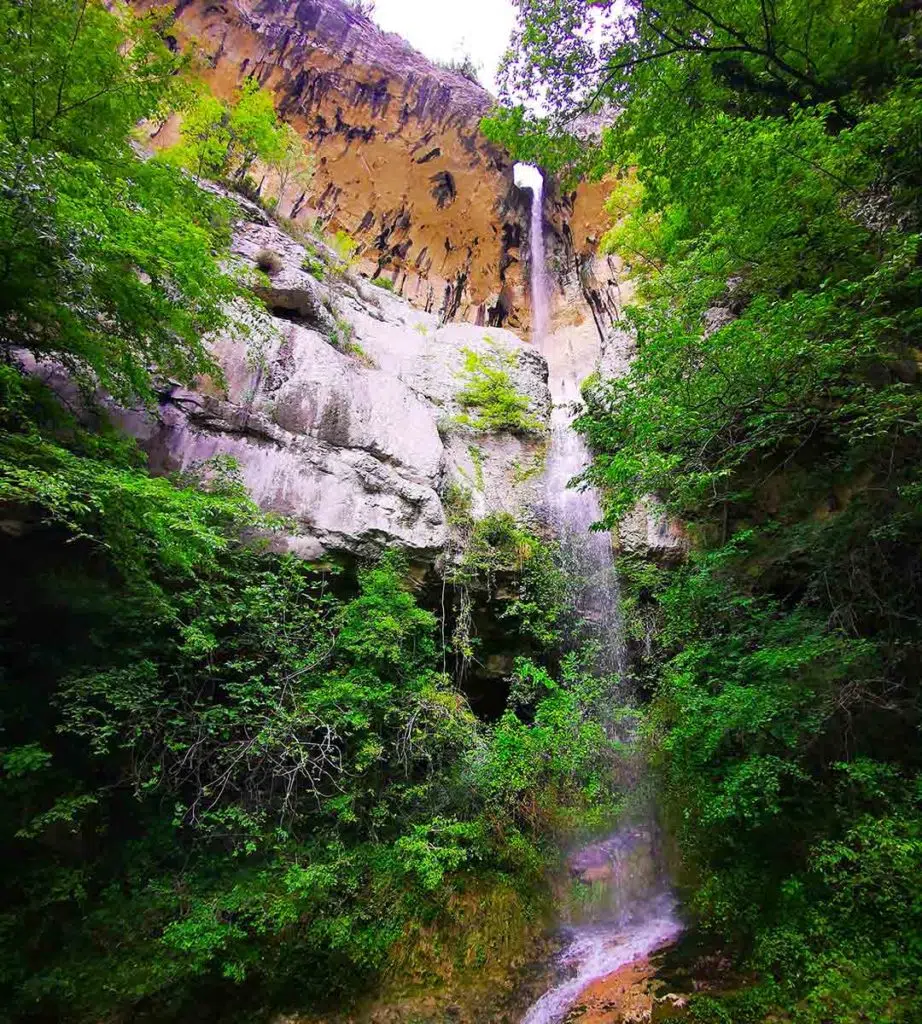
There is another waterfall called Sopot (but usually called Copot) in Istria near Buzet that is worthy of an excursion. It is located on the river Rečica near Podbreg. It is special because it is extremely high (30 m, the second highest Istrian waterfall after the Vela Draga Rain Waterfall).
The water at the top of the waterfall passes through a hole dug by water in the rock. The waterfall shares its name with the more famous waterfall at the foot of Pićan, slightly lower (24.5 m). You will often see that Buzet's Sopot is also called Copot.
Interesting: The waterfall is also a climbing area. Among the climbers, the locality is called Pandora because of its exceptional attractiveness and similarity with the place of action in the movie Avatar.
The road access to the village is a road branch near Čiritež. You pass the village of Brgad, drive a short macadam road, and come to the town of Strana.
A signpost for the climbing area appears after descending the asphalt road for about 200 meters. It is a 10-minute walk to the waterfall along the path from here.
Vela Draga Waterfall
If you are lucky, you may witness a rare waterfall Vela Draga at the entrance to the Učka tunnel on the west side. With a drop of 50 m, it is the highest waterfall in Istria. It is located within Vela Draga (also Vranjska Draga) canyon valley at the northwestern foot of Mount Učka.
Interesting: The location o the waterfall is very unique. Unsurprisingly, the 1964 Western Winnetou was filmed here since there is an abandoned railway and a tunnel nearby.
It was formed by the action of water torrents in the limestone rock. It is part of the Učka Nature Park. It appears occasionally and for a short time, only when a torrent of water accumulates after heavy rain, so it doesn't even have an official name.
Rainfall from the slopes of Učka collects in torrents, some of which end in Vela Draga in its easternmost part, the edges of which are cut off vertically. The stream continues towards Boljunsko polje, where it joins the stream Boljunčica.
Surrounding the waterfall is the untouched nature with the interesting phenomenon of spiky rocks whose towers reach a height of almost 100 meters (the most famous pillar is symbolically called the Candle).
Waterfall Butori Ponor
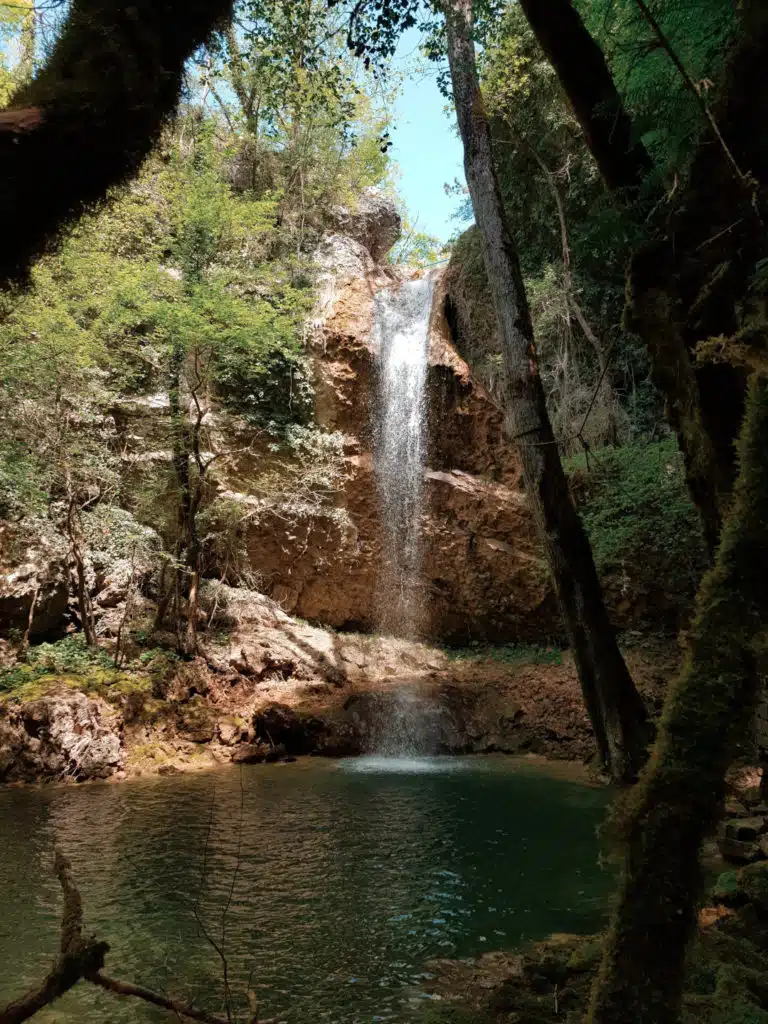
The Butorni Ponor waterfall is about 10 m high, emerges from the Jugovski stream or Arđil, falls into lakes, and then disappears into a sinkhole, giving the surrounding area a fairytale atmosphere.
It is located in the Buje region, next to the place Marušići on the road Buje - Šterna, or you can also reach it via Oprtalj, depending on which side you come from.
Interesting: The sinkhole was discovered to be a length of 500 meters and has a depth of 230 meters. When there is no water, the entrance to the sinkhole can be seen.
The waterfall and the abyss sinkhole make up an interesting but little-known karst phenomenon in Croatian Istria.
The waterfall is fenced, and the path to its base is protected by a fence, making it easy to descend. Unfortunately, you cannot walk around the bottom of the waterfall because there is a deep lake, but you can pass under the waterfall.
A little further, upstream from the waterfall, ten meters from the left bank of Jugovski Potok, there is an abandoned mill.
Tip: The waterfalls can also dry up completely due to the lack of water in Istria in the summertime. Make sure you know it has recently rained, so you don't travel in vain.
Water, the forest, the old mill, and moss create a serene meditative environment. Every August, local artists celebrate this fact in Butori with bonfires, lamps, and torches during the Meeting of Forest Poets.
Butoniga Waterfalls
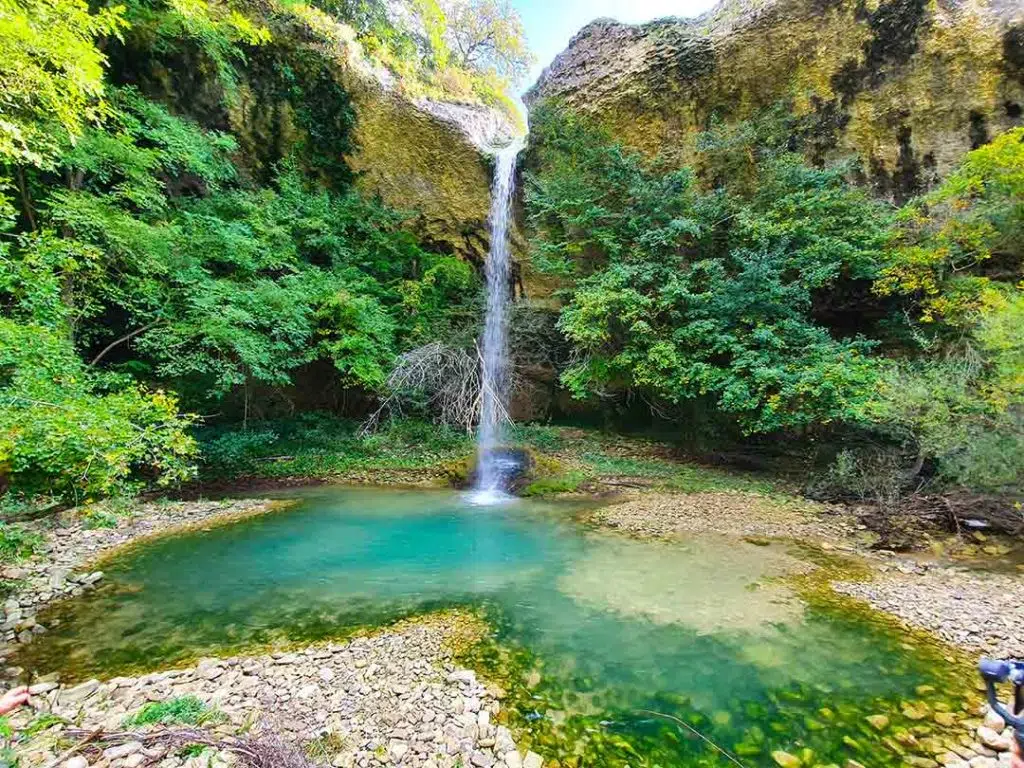
On the road Pazin - Kršikla in Istra, about three kilometers from Kršikla, there is a tiny settlement of Butoniga. A stream of the same name flows through the village, one of the three main tributaries of the accumulation lake Butoniga (the other two are Dragučki and Račički streams).
Veli slap is an 8 m high waterfall on the Butoniga stream, located on the turn for the villages of Bašiće and Cesare.
Photo tip: Interestingly, you can get behind the waterfall and stay dry because there is a semi-cave below the Veli slap waterfall.
If you follow the Butoniga stream downstream to the Grdoselo or Zelengrad, you can find several other smaller waterfalls:
- Mali slap waterfall - 5 meters
- Črni puč waterfall - 3 meters
- Pećine waterfalls - 15 meters
- Pod Klečom – 7 m
- Malenica – 3 m
- Sedreni slap – 2 m
Štrbački Buk
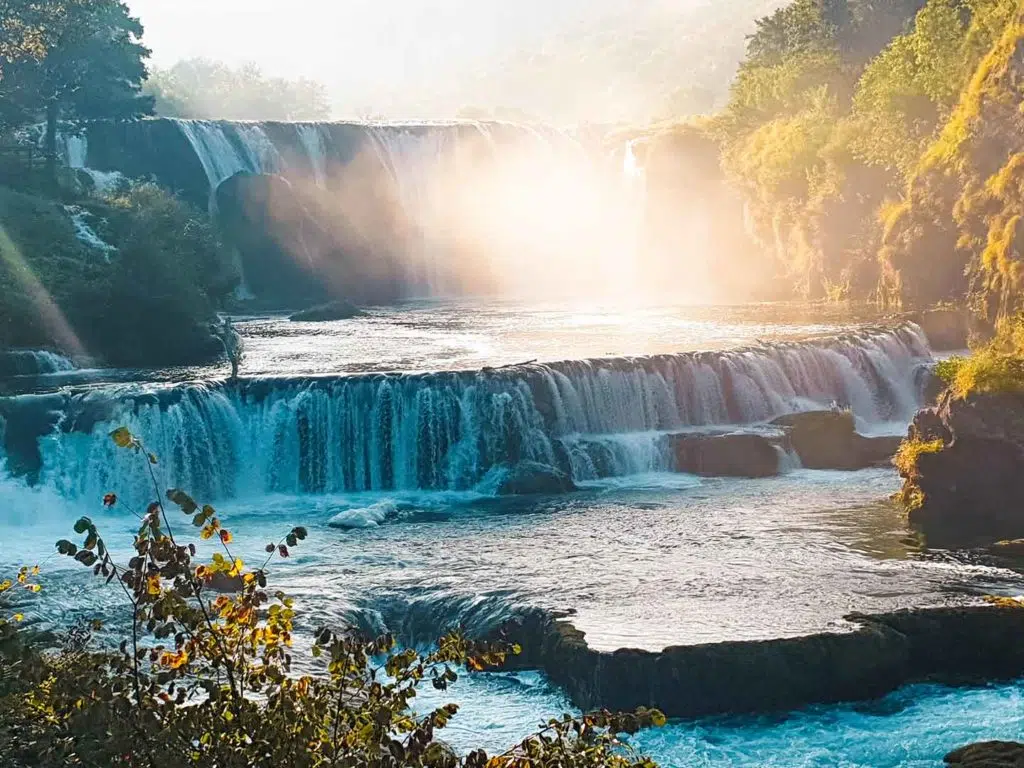
Štrbački Buk is a 25 meters (82 ft) high waterfall on the river Una near the settlement of Martin Brod, located near the border between Bosnia & Herzegovina and Croatia. Štrbački Buk consists of several waterfalls close to each other.
Una river drops down a series of waterfalls and cascades, creating travertine formations. It is part of the Una National Park.
Access: Although the waterfalls are named after the nearby town of Donji Strbci in Croatia, they are easiest to reach from the Bosnian side, turning in Orasac on a macadam road about 7 km long.
The power of the waterfalls can be felt in the noise and drops splashing in all directions, which comes in handy as a refreshment on hot summer days.
Rafting is also an option for adrenaline seekers. As opposed to other rivers, rafting on the Una, or Strbački Buk, is entertaining and exhausting.
Glogorički Dol
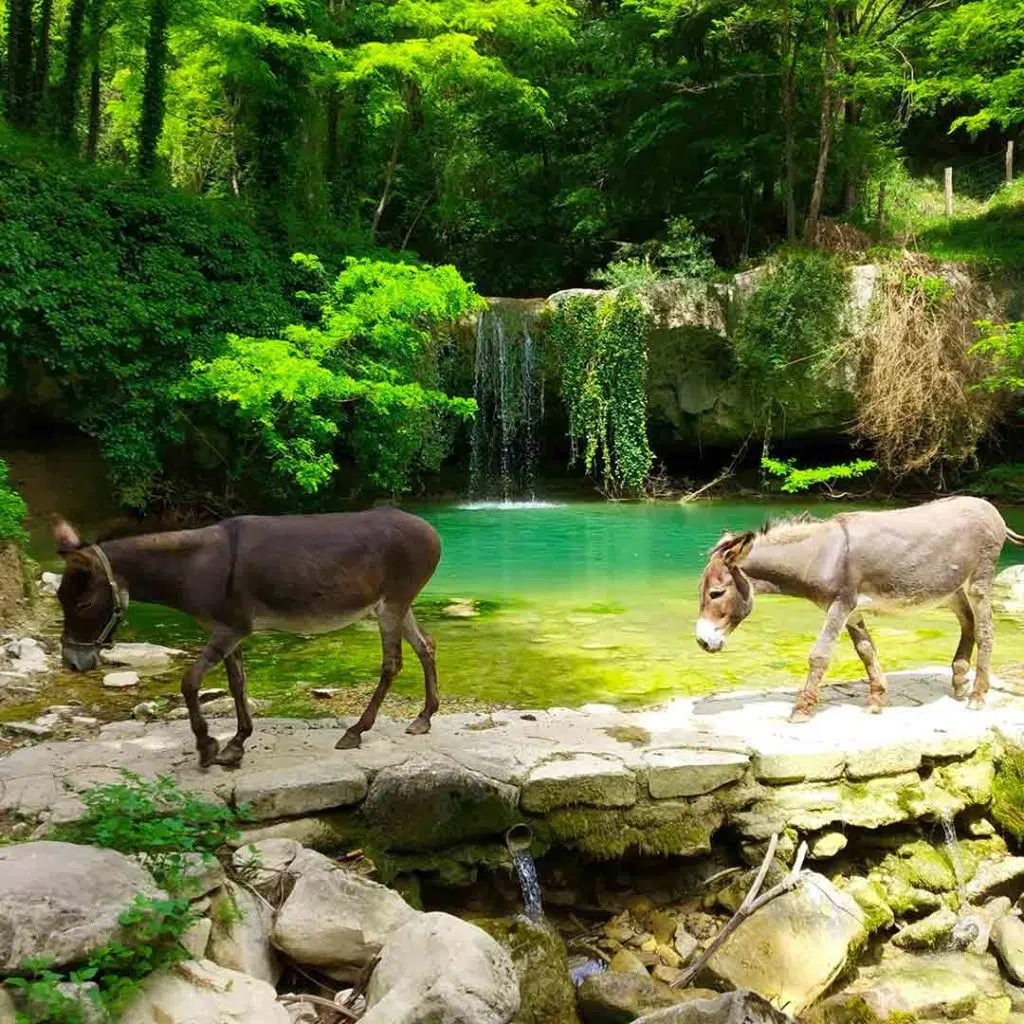
Gologorica lies 5 km southeast of Cerovlje in Istria. Lower in the valley is Gologorički dol, reachable through a narrow, steep road offering beautiful views of the landscape and surrounding Istrian hills.
The waterfall is approximately 3 meters high and part of the Raša river basin. It descends into an emerald pond over ivy growing on the rocks. A typical karst Istrian feature is present; a cave roof over a pond.
Location: Turn right before coming to the valley, in the direction of Lukacic. After 500 m, take a sharp left turn, and you will come to a bridge over the Gologoricki creek. Here you will find the Gologoricki Dol waterfall.
You reach the waterfall through a wooden door so domestic animals do not escape. Still, you are free to enter and enjoy the murmur of the waterfall and the animals around it.
There are tables and benches near the pond for relaxing and taking in this little natural pearl. You can expect to be surrounded by Istrian domestic animals in no time: donkeys, ducks, and geese.
Children can enjoy it the most here, so it is not surprising that this waterfall is a frequent destination for school and kindergarten trips.
The best time to visit the waterfall should be after a rainy day when the volume of water increases—the waterfall may dry out in the summertime.
Kotli Waterfall
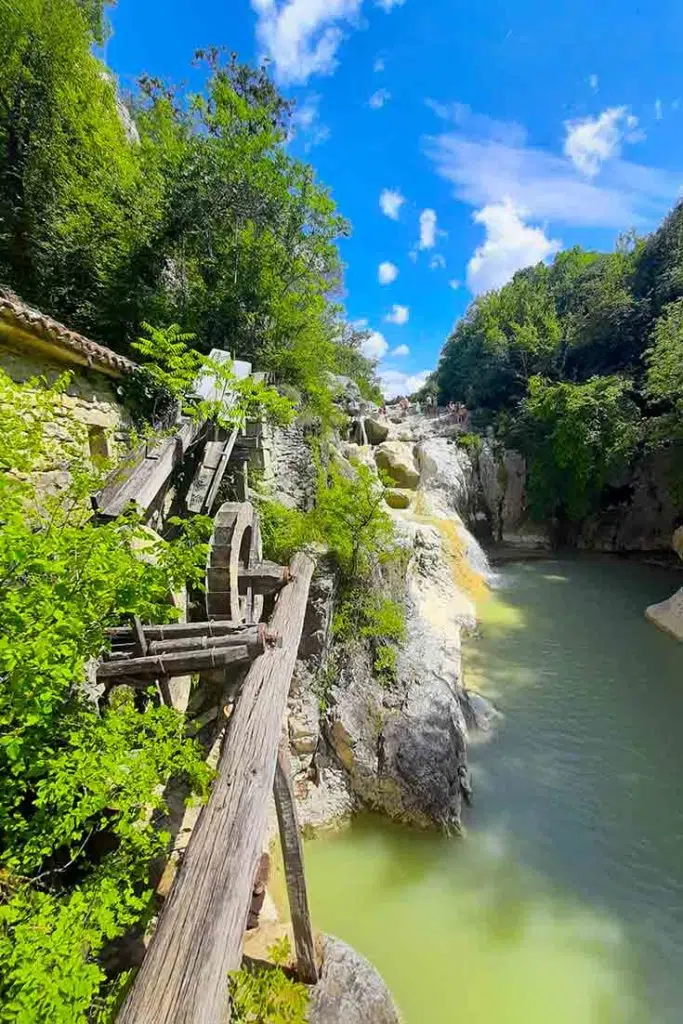
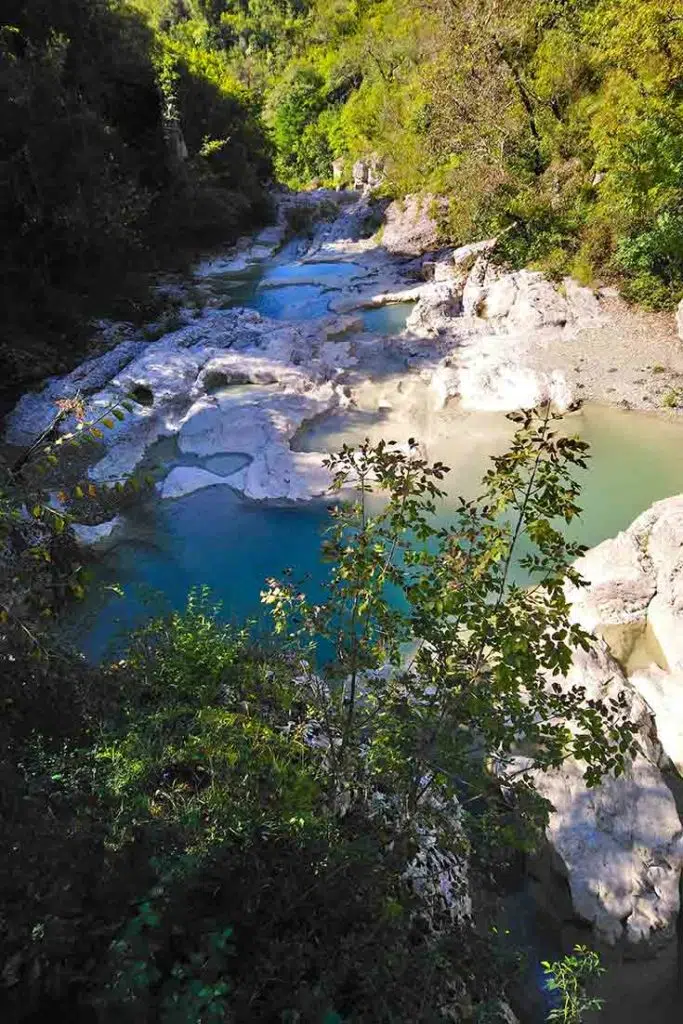
Kotli is a picturesque abandoned village on the bed of the river Mirna, which cascaded carved picturesque hollows resembling cauldrons in the limestone and flysch rocks. Located close is the eponymous Kotli waterfall, at 12 m high and 7 m wide.
Kotli waterfall is a part of the Seven Waterfalls Trail. This trail follows the flow of the Mirna River. Buzet, a hilltop town with scenic views of the Mirna River Valley, is the trail's starting point. There are seven waterfalls on the trail, reaching heights of up to 26.5 meters.
Interesting: Because of these visually attractive pools, many visitors compare Kotli to the popular Turkish destination Pamukkale. The shallow turquoise pools are created by overflowing mineral water and sedimentation and are an ideal place to relax sitting, soaking in these natural jacuzzis.
Once Kotli village was known for tailors and millers with more than a hundred inhabitants. People began to leave after World War II in search of a better life in cities. Its last inhabitants left in the 70s. Today, stone houses and old mills still stand there.
Despite that, the village has become a favorite destination for nature lovers visiting the Kotli waterfall, so you rarely see this place without people.
Draški Waterfall
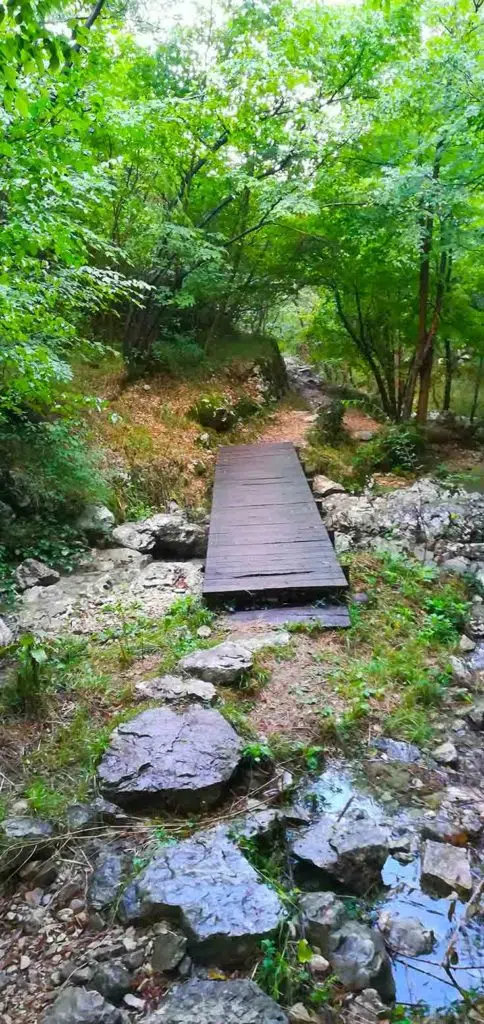
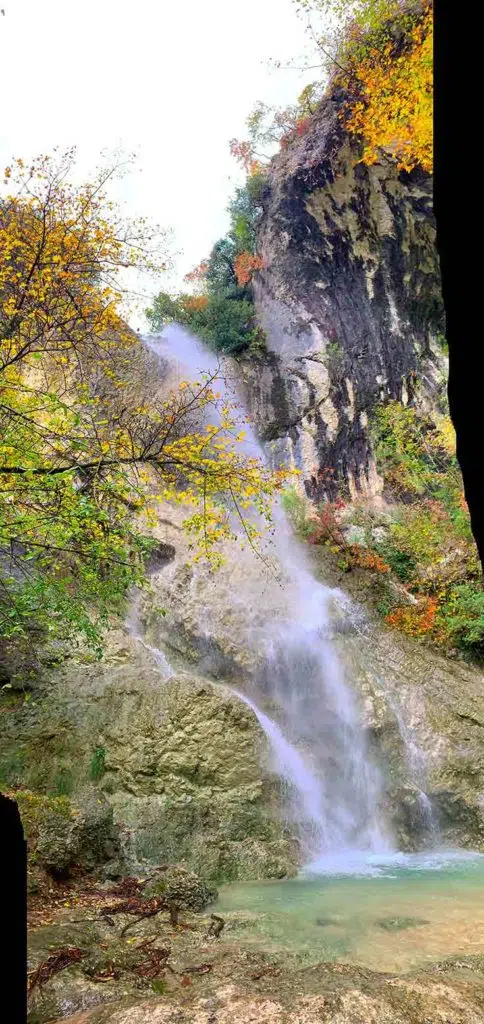
Draški slap is located at the end of the Slap promenade. The "Slap" walkway passes through the area of Lovranska Draga, one of the most beautiful and expressive torrent streams in the Učka Nature Park.
Draški waterfall is 15 meters high. At the bottom of the waterfall is a small lake from which the water continues along the stream Potok through the village Lovranska Draga and further to the town Medveja and ultimately flows into the Kvarner Bay. The waterfall is fed by streams that spring in several places within the canyon.
Tip: If you decide to visit make sure to pay attention to educational panels on the flora and fauna of this area have been set up on the Slap trail. The trail is 1,600 m long in both directions with an altitude of 359 meters.
On the 30-minute walk along the trail to the attractive waterfall, you pass through chestnut groves, oak and hornbeam forests, and over old terraces where the land used to be cultivated.
Gubavica Waterfall
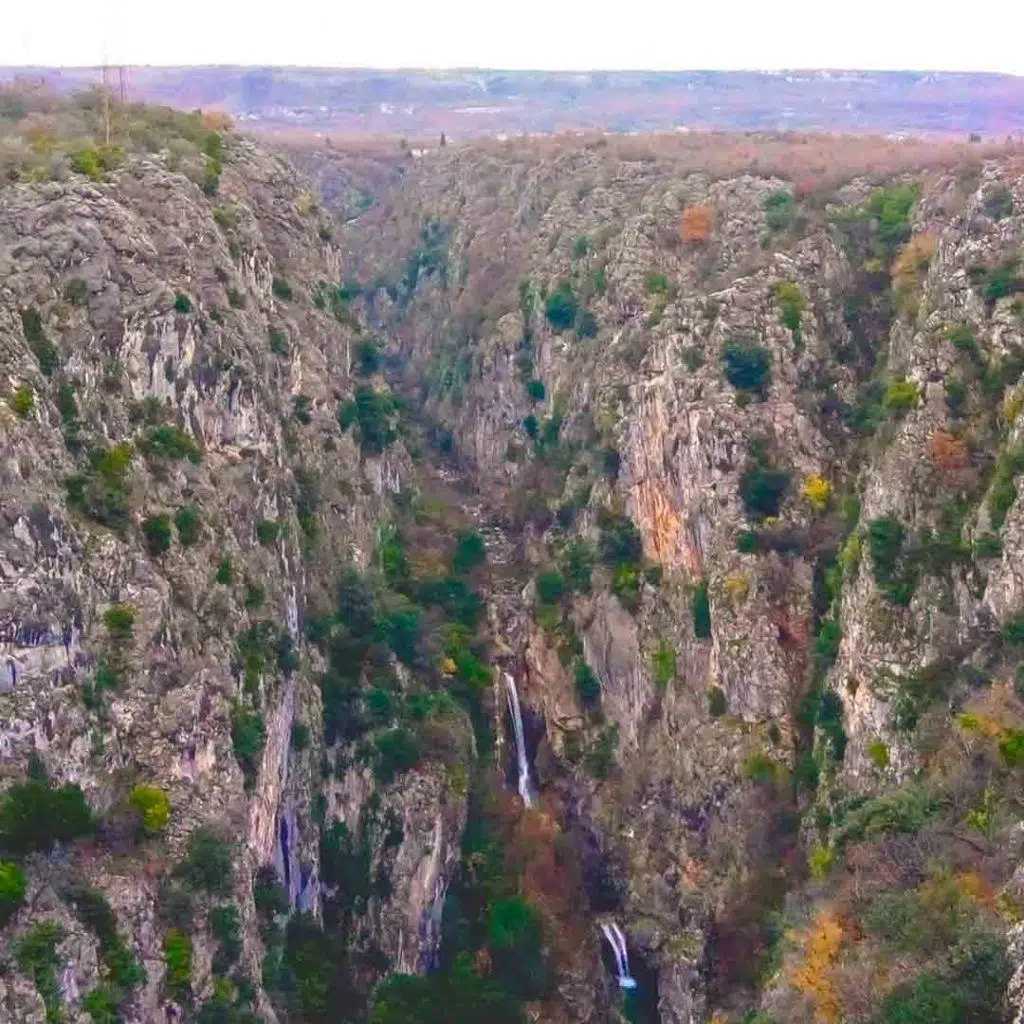
Gubavica waterfall is the culmination of the Cetina canyon, which stretches from Blato on the Cetina to Zadvarje, after which the Cetina flows more calmly across the valley towards the mouth.
Waterfalls Velika Gubavica (48m) and Mala Gubavica (7m) are formed in the 200 meters deep canyon of the karst plateau of Zadvarje and collapse into their lower bed with a loud noise and crash.
Tip: The waterfall can be seen from a distance of the lookout point that is easily accessible by car. A simple detour to visit this idyllic place in the Dalmatian hinterland is worth it.
The waterfall is especially impressive in the rainy season when significant water flows through the canyon. The water then crashes into the ravine from circular openings in the rock at its side.
The entire canyon is filled with millions of tiny drops of water and a deafening roar. You can often see groups of adventurers in life vests and helmets next to the waterfall. Tour agencies organize tours exploring the canyon and the waterfalls with climbing gear.
When it rains heavily, and there is an excess of water in the accumulation lakes, a series of six waterfalls is created instead of these two waterfalls. Unfortunately, there is no well-maintained path to the waterfalls, so access is very dangerous due to impassable terrain and unpredictable large discharges of water from reservoirs.
In addition, of course, like all waterfalls in the karst, Gubavica can dry out during the summer.
Bilušića Buk
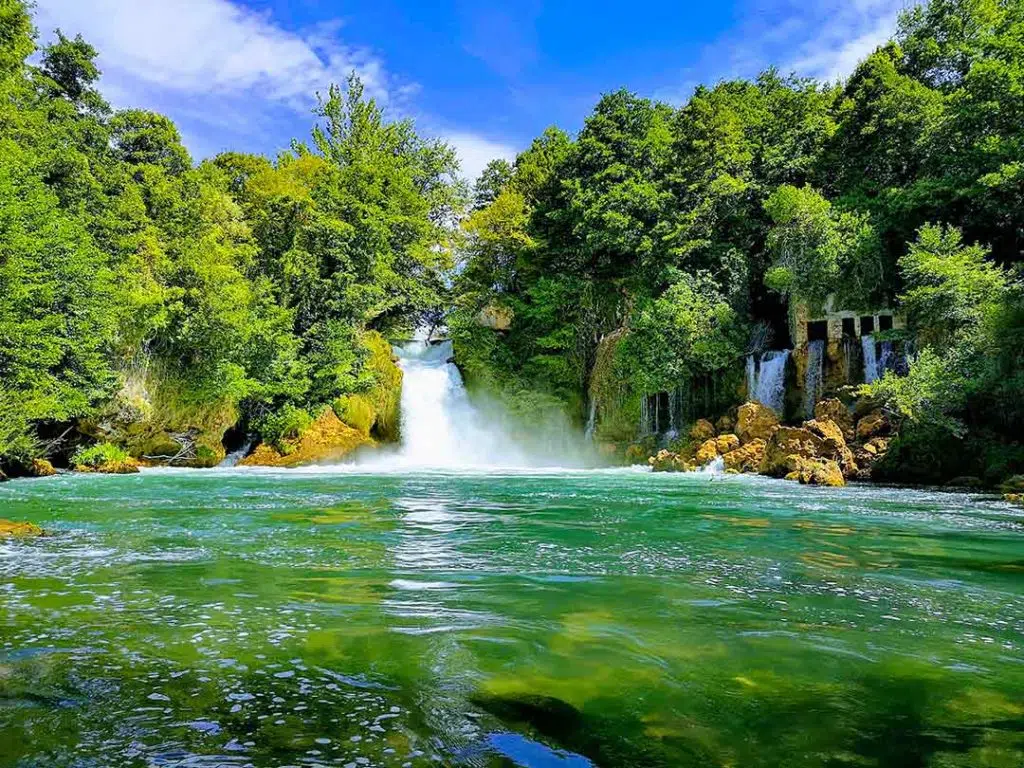
Bilušića buk is the first of 7 travertine waterfalls along the Krka River. It is 100 m wide and consists of two main and intermediate stairs at 300 m.
The entire width of the Krka River is compacted into a relatively narrow gap (6-7 m), and the waterfall falls with great force from a height of over 22 m. The power is so great that the water occasionally bounces off the river's surface and rises again.
Interesting: There are several speleological objects in or near the travertine barrier of the Bilušića buk waterfall you can check out when visiting, the most notable of which is the Travertine Cave.
Downstream from the waterfall, we find numerous barriers, and just below them, travertine thresholds and islets. You can see the excellently preserved and extremely attractive fossil travertine. There is a small pond between the travertine steps.
After the lower stage, the river widens, and the flow calms down. The waterfall is surrounded by lush sub-Mediterranean vegetation and dense willows.
Along the river, there are several small fields where vegetables are planted. The appearance of Bilušića buk waterfall was changed four times by blasting rocks to prevent flooding of Kninsko polje.
Today, this waterfall is neglected, and of the farm buildings that were once in operation, only the mill has been preserved today as a former indicator of the traditional economic development of the area. The waterfall is surrounded by small fields where the locals grow vegetables.
Krupa Waterfalls
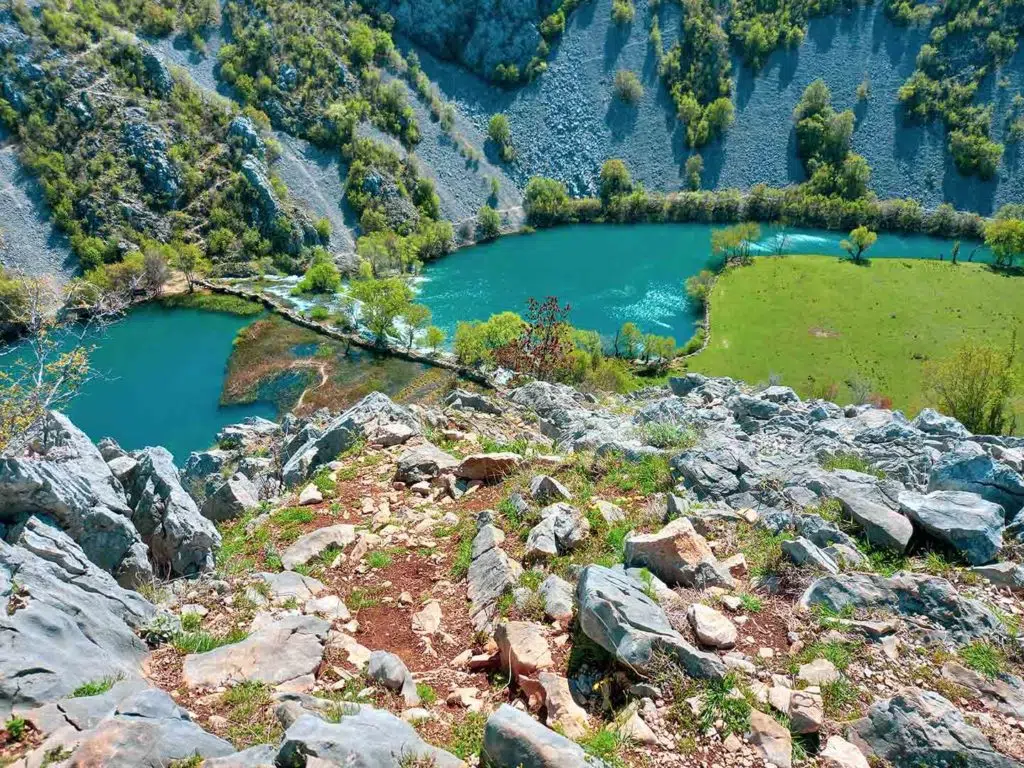
An hour's drive from Zadar, near Obrovac, there is a paradise for walkers, hikers, trekkers, and nature lovers that looks like the most beautiful postcard. At the foot of the southern slopes of Velebit flows the river Zrmanja, into which flows the Krupa, a clear mountain river that flows through the canyon and occasionally rushes into the free fall.
Turquoise, blue, and dark blue shades framed by wild greenery and the sharpness of the rocks represent a special experience. There are 19 waterfalls on the Krupa river, most of which, with their height, shape, and indentation, are among the most beautiful Croatian waterfalls.
The most famous is the Deveterac waterfall, named after nine travertine cascades that end in a 13-meter-high waterfall over which the Kuda Bridge leads. Although the last two left arches have been significantly damaged, the Kuda Bridge defies weather and high waters.
Tip: Late summer or early autumn is the best time to take a walk along the hiking trail that follows the river because then Krupa is a bit smaller and calmer until heavy rains when it swells and grows in the spring so much that it makes walking difficult.
The Panin Buk waterfall follows it, then the canyon in the Veliča Luka area drops slightly.
The canyon again reaches an enviable height by squeezing the river with a rock at the foot of Babin Grad into a narrow gorge where three waterfalls are lined up.
After an 8-meter-high Dragicevic Buk waterfall, the noise of Krupa forms picturesque elongated travertine thresholds, falls over two smaller waterfalls, and finally hands over its waters to Zrmanja.
Krupa has its tributary Krnjeza, which springs from a huge cave at the foot of Velebit and flows into Krupa after a short flow. Krnjeza is one of the shortest rivers in Croatia, only 600 m long and up to 45 m deep in some places.
Miljacka Waterfall
A kilometer downstream from Rošnjak in the NP Krka, squeezed in the riverbed between high rocks overgrown with lush vegetation, is Miljacka waterfall. Miljacka is the fifth travertine barrier of the river Krka.
It consists of three larger and numerous smaller travertine steps with a total height of 23.8 meters. The waters of the Krka River are joined here by the Zrmanja River through the Miljacka spring. The source is a direct link between Zrmanja and Krka and is a unique hydrogeological phenomenon.
At the foot of the waterfalls, on the right bank of the river, there are several collapsed mills and a water intake for Kistanje, and on the left bank is the hydroelectric power plant "Miljacka."
Access: Visiting the waterfall individually is not possible because it is only accessible through the space of the Miljacka Hydroelectric Power Plant. Still, it can be seen from the paths on the northwest side of the Krka.
Downstream from the waterfall on the right bank of the river is the cave Miljacka II. Numerous endemic and protected subterranean animals inhabit it.
Milke Trnine Slap
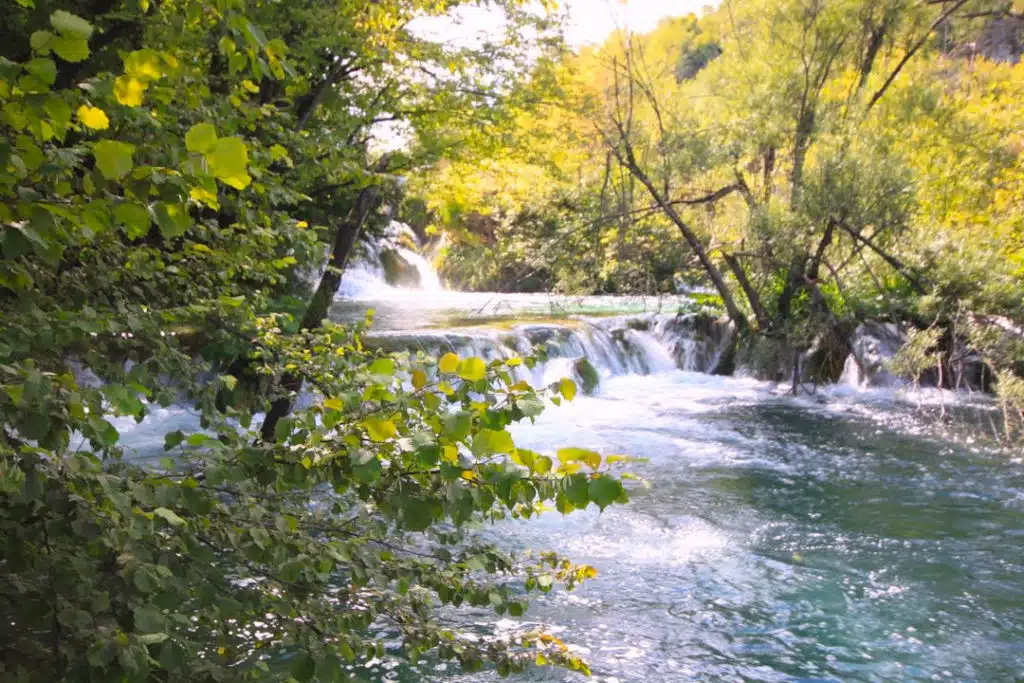
Located near Plitvice Selo at the end of the lakes, near the park's Entrance 1, Milke Trnine Slap is a beautiful waterfall in Plitvice National Park. The river Korana water from Milanovac lake drops over the 6 meters high travertine waterfall, crashing into the lower Lake Gavanovac.
The waterfall is a series of scenic little cascades running among low vegetation and tall trees across the slow barriers from one lake to another.
The waterfall was named after the person Milka Trnina. She was a famous late 19th-century opera singer, soprano Milka Trnina. She was known for being friends with the great Croatian inventor Nikola Tesla.
During her visit to Zagreb in 1898, she prepared a farewell play. She gave money from the farewell play to the Society for the Beautification of Plitvice Lakes and Tesla's native Lika. As a token of gratitude, the Society named one of the most beautiful Plitvice waterfalls Milka Trnina Waterfall.
The best way to escape the crowds and return to nature is to visit one of these incredible Croatia waterfalls! Not all of these are easily accessible, but the journey is usually well worth the effort. You may have to pay an entrance fee to some of these, but you won't find the price as excessive as you would expect if you want to see incredible natural surroundings.
